
Research project brief
Optimize research success with structured planning. Unlock methodological clarity with our project brief template.
Share this Template
Your guide to effective research planning
Crafted for simplicity and effectiveness, our research project brief template is the key to successful research management. It's perfect for researchers, academic institutions, and businesses aiming to conduct research with precision and ease. This template is a clear guide, aligning every project detail for smooth progress. It transforms the complex task of planning and executing various research projects into a more manageable and streamlined process.
Benefits of using the research project brief template:
Enhance your research projects with our template, designed to optimize every phase:
- Structured clarity: Simplify your project's outline, ensuring everyone involved shares the same vision and goals.
- Efficient resource management: Manage budgets and timelines effortlessly, maximizing your research's potential while avoiding unnecessary costs.
- Proactive risk management: Anticipate challenges early on for smoother project progression.
- Strategic dissemination: Develop effective strategies to share your findings, increasing their impact and relevance in your field.
These features combine to create an effective, clear, and strategic research management process.
Key components of the template:
Craft your research project carefully by utilizing these components tailored to ensure a comprehensive and strategic approach:
- Project overview: Capture vital project aspects like the title, duration, and a concise yet impactful description, highlighting the research's significance for better stakeholder engagement and understanding.
- Objectives and goals: Define primary and secondary research objectives while delineating the intended audience, providing a clear direction for the research and ensuring relevance to stakeholders.
- Scope of work: Delve into research methodologies, data collection techniques, and analysis approaches, furnishing an in-depth insight into the research methods adopted for a thorough understanding.
- Budget and resources: Strategically allocate funds, break down costs, and identify any additional resource requirements, ensuring financial transparency and optimal resource utilization throughout the project.
- Timeline and deadlines: Structure key research phases and milestones with a clear timeline, ensuring efficient progress and goal attainment while managing time effectively.
- Communication plan: Establish robust communication channels among the research team and stakeholders, fostering a cohesive approach and facilitating information flow for smoother project execution.
How to make the most of this template
Kickstart your research project with precision. Define clear objectives, delve into detailed methodologies, and allocate resources efficiently. This approach not only ensures clarity and integrity but also fosters effective progress and impactful results.
Embrace the power of this template for straightforward planning and clear methodologies in your research. Ready to transform your research planning? Start streamlining your process today with our comprehensive template!
FAQ About the Research project brief Template
Trusted by millions, including teams at

Discover More Templates
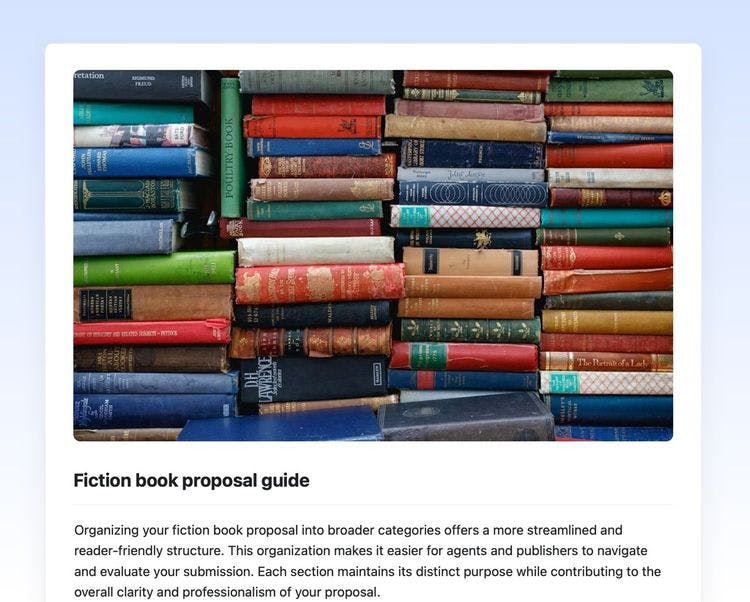
Take impactful to a whole new level
Always with you
Easy to use
Works your way
Powerful Features
Get in or get out
Offline first
Beautiful sharing
You’re not alone
We’re here to help
- Business & Enterprise
- Education, Learning & Skills
- Energy & Environment
- Financial Services
- Health & Wellbeing
- Higher Education
- Work & Welfare
- Behavioural insights
- Business Spotlight – IFF’s business omnibus
- Customer experience research
- Customer satisfaction measurement
- National statistics and complex surveys
- Stakeholder research
- Tenant satisfaction measures
- Our approach
- Trusted partner
- Equality, diversity & inclusion at IFF
- Sustainability at IFF
- Charity giving
- Meet the team
- News & resources
- Case studies
How to write an effective research brief
Whether you’re launching a simple survey or planning a large-scale project the quality of your brief will hugely impact on the value you get from the research. While it can take a little time and effort creating a research brief, it will undoubtedly be time well spent – getting you better results and return on your investment and saving you valuable resources on further clarification. At best, a poor brief will be a time drain on you and your team. At worst, the findings will fail to meet your objectives, costing you time and money.
We’ve seen a lot of research briefs over the years. Some of which have been well thought through and clear, helping us prepare a detailed proposal and deliver an effective project and subsequent results. And others which have been not so good, lacking clarity or detail.
Using this experience, we’ve put together a ‘how to’ guide on writing an effective research brief, to help you ensure success on your next project.
1. Preparation is key
As with any project, before you start it’s crucial you think through what you want and need to deliver. Here are some things you should consider:
- Why are you conducting the research? What exactly are you looking to understand?
- Who are you looking to understand better? Who do you need to speak to answer your research questions?
- Who are your internal stakeholders? Have you discussed the project needs with the people in your organisation who will use the findings or who are invested in the research?
- How will the findings be used?
- When do you need the findings?
- Have you agreed a budget with either your procurement team, or the relevant person in your organisation?
2. Be clear on your objectives
This is one of the most important parts of your brief to convey to the reader what you want out of the project and ensure you get results which deliver.
Projects should have around three or four overarching aims which set out what the project ultimately wants to achieve.
These might be things like:
- Assess the impact of……
- Examine views of…..
- Evaluate the effectiveness of….
In addition to project objectives, you should also include the key questions you want the research to answer. These should support you in meeting the aims of the research.
For example, if the project aim is to assess the impact of an intervention, your research questions might include:
- Who did the intervention target?
- What did the project deliver?
- What elements were successful, and why?
- What were the main enablers and barriers?
3. Remember your audience
Research agencies or organisations who will be responding to your brief might not know anything about your business. So, make sure you include enough background information in your brief to enable them to understand your needs and deliver effectively. And avoid use of jargon or acronyms which could lead to errors or confusion.
4. Structure your research brief
Before you start to populate your brief it’s worth considering all the information and sections you need to include, to structure your thinking and ensure you don’t miss anything important.
This might include some, or all, of the following:
- Background info
- Introduction
- Aims and objectives
- Research Question(s)
- Issues / Risks
- Methodology
- Timing and Outputs
- Project Management
5. Make it thorough, yet succinct
While it’s crucial to include all the relevant information to enable bidders to respond effectively, no one wants to read reams and reams of information. To avoid the key information getting lost in the details use annexes to add supplementary information which could be useful.
6. Consider how prescriptive you want to be on the methodology
The extent to which you want to specify the methodology will depend on the project you aim to deliver. There are benefits and risks to being overly prescriptive or offering free reign. If you outline in precise detail how you want the research to be conducted, you will hamper any original ideas from those invited to tender and might limit the impact on the research. Whereas, if you’re less prescriptive, allowing room for creativity, you risk not getting the project or results you want, or receiving proposals on a scale which you can’t resource.
Generally, it is useful to allow those invited to tender some scope to develop the methodology they propose to use. Exceptions might be where previous work has to be very precisely replicated or some other very precise commitment about the nature of findings has been given to stakeholders.
7. Define your timelines
As a minimum, you need to include when you want the project to start and end. But you should also include the timetable for procurement. When planning this, don’t underestimate the time and resource needed to run a procurement exercise. Make sure your evaluators are available when you need them and have enough time blocked out in their diary.
You’ll likely also want to include milestones for when you expect outputs to be delivered, such as deadlines for a draft report (providing opportunity for review and feedback) and the final report; allowing sufficient time between the two to enable your stakeholders to consult, for you to feedback and for the contractor to revise the report.
8. Set expectations on cost
You will most likely have budgetary constraints, with a figure for what you are prepared to spend. To save you and your bidders time, and to set realistic expectations, you should include an indication within your brief. This will prevent you receiving proposals which are way out of the ballpark; enable bidders to plan a project which delivers on (or at least close to) budget; and will prevent any nasty surprises, further down the line.
By following these tips you’ll be well on your way to creating an effective research brief which delivers on time and on budget.
If you’d like more guidance download our “step-by-step” guide, which includes a template and information for what to include in each section to ensure success.
Download the guide now.
Ready to level up your insights?
Get ready to streamline, scale and supercharge your research. Fill out this form to request a demo of the InsightHub platform and discover the difference insights empowerment can make. A member of our team will reach out within two working days.
Cost effective insights that scale
Quality insight doesn't need to cost the earth. Our flexible approach helps you make the most of research budgets and build an agile solution that works for you. Fill out this form to request a call back from our team to explore our pricing options.
- What is InsightHub?
- Data Collection
- Data Analysis
- Data Activation
- Research Templates
- Information Security
- Our Expert Services
- Support & Education
- Consultative Services
- Insight Delivery
- Research Methods
- Sectors We Work With
- Meet the team
- Advisory Board
- Press & Media
- Book a Demo
- Request Pricing

Embark on a new adventure. Join Camp InsightHub, our free demo platform, to discover the future of research.

Read a brief overview of the agile research platform enabling brands to inform decisions at speed in this PDF.
InsightHub on the Blog
- Surveys, Video and the Changing Face of Agile Research
- Building a Research Technology Stack for Better Insights
- The Importance of Delegation in Managing Insight Activities
- Common Insight Platform Pitfalls (and How to Avoid Them)
- Support and Education
- Insight Delivery Services

Our services drive operational and strategic success in challenging environments. Find out how.

Close Connections bring stakeholders and customers together for candid, human conversations.
Services on the Blog
- Closing the Client-Agency Divide in Market Research
- How to Speed Up Fieldwork Without Compromising Quality
- Practical Ways to Support Real-Time Decision Making
- Developing a Question Oriented, Not Answer Oriented Culture
- Meet the Team

The FlexMR credentials deck provides a brief introduction to the team, our approach to research and previous work.

We are the insights empowerment company. Our framework addresses the major pressures insight teams face.
Latest News
- Insight as Art Shortlisted for AURA Innovation Award
- FlexMR Launch Video Close Connection Programme
- VideoMR Analysis Tool Added to InsightHub
- FlexMR Makes Shortlist for Quirks Research Supplier Award
- Latest Posts
- Strategic Thinking
- Technology & Trends
- Practical Application
- Insights Empowerment
- View Full Blog Archives

Discover how to build close customer connections to better support real-time decision making.

What is a market research and insights playbook, plus discover why should your team consider building one.
Featured Posts
- Five Strategies for Turning Insight into Action
- How to Design Surveys that Ask the Right Questions
- Scaling Creative Qual for Rich Customer Insight
- How to Measure Brand Awareness: The Complete Guide
- All Resources
- Client Stories
- Whitepapers
- Events & Webinars
- The Open Ideas Panel
- InsightHub Help Centre
- FlexMR Client Network

The insights empowerment readiness calculator measures your progress in building an insight-led culture.

The MRX Lab podcast explores new and novel ideas from the insights industry in 10 minutes or less.
Featured Stories
- Specsavers Informs Key Marketing Decisions with InsightHub
- The Coventry Panel Helps Maintain Award Winning CX
- Isagenix Customer Community Steers New Product Launch
- Curo Engage Residents with InsightHub Community
- Tech & Trends /
- Research Methods /
- Strategic Thinking /
How to Write a Market Research Brief (+ Free Template)
Emily james, the connection between customer salience and marke....
In today’s day and age, it is hard for insight experts to imagine that some stakeholders still don’t...
- Insights Empowerment (29)
- Practical Application (173)
- Research Methods (283)
- Strategic Thinking (198)
- Survey Templates (7)
- Tech & Trends (387)
A market research brief is a document a client produces detailing important information about their unique situation and research requirements. This information should include (but is not limited to) the context of the situation in which the decision to conduct research was made, the initial objectives, and the resulting actions that hope to be taken after the research has concluded.
This brief would come before the typical market research plan (see our example here ), and so any information that is contained within the brief will be subject to modification once in-depth chats between the client and the research agency have been conducted.
This is one of the most important initiating steps for market research as it provides the necessary information that researchers need to understand your needs as much as you do yourself. There is a lot to be said for being on the same page at this early stage of the research experience. While different agencies will prioritise different aspects of the research project, 90% of the brief will follow the same lines, so a draft should always be made and then it can be easily edited to the agency’s requirements.
Why Create a Market Research Brief?
Writing up a brief is essential for the clear communication of your research requirements. Clear communication from the very start is essential if a positive working relationship is going to bloom between the parties involved. This brief outline of a business’ unique scenario communicates information that researchers need in order to achieve a high level of understanding which they can use to create and further refine a detailed plan the research experience.
Key Components
Just looking at the many template designs out there, we can see that a research brief has a few key aspects that everyone agrees are important:
1. Contextual Information
Now this can be interpreted in two ways, both of which should be included within the market research brief. The first interpretation is contextual information relating to the business hiring the research agency. What does the business do? What are it’s values? How is it run? And then the second interpretation is contextual information relating to how the need for research arose. What are the steps that took place towards the realisation that research was needed? This timeline could span months or just days, but even so, the detail must be included for the researcher to get a full understanding of the situation at hand.
2. Description of Research Purpose
At this point, a description of the product (or service) which is to be researched is needed; whoever is carrying out the research will need to know as much detail as possible about the subject of the study as this will have a big influence on the research method used (more information on that to come).
A description of the target markets will also be needed at this point: covering the geographical territories, the target audience (consumers vs. potential consumers) and any specific demographics that should be included or excluded. If this information is known, an approximate sample size can also be noted down.
If a business is wanting to test adverts, product examples, etc. then example designs or prototypes are going to be needed for both the researcher and the participants to use in the formation of the research tasks and the generation of data.
3. Objectives
Again, this aspect of the brief can be split up into two equally important interpretations. The objectives of the business are incredibly important as they provide another level of contextual understanding for the researcher. The other set of objectives that are needed within the brief, are the research objectives. Now, these are usually formed as questions that the business would like answered, but are subject to modification with the input of the researcher as they will know what is achievable, and what the business needs instead of what they want. Research objectives also cover what the business want to do with the insights generated as that gives an indication of what sort of research needs to be conducted. For the best research experience that ends in fully applicable insights, aligning business and research objectives is imperative.
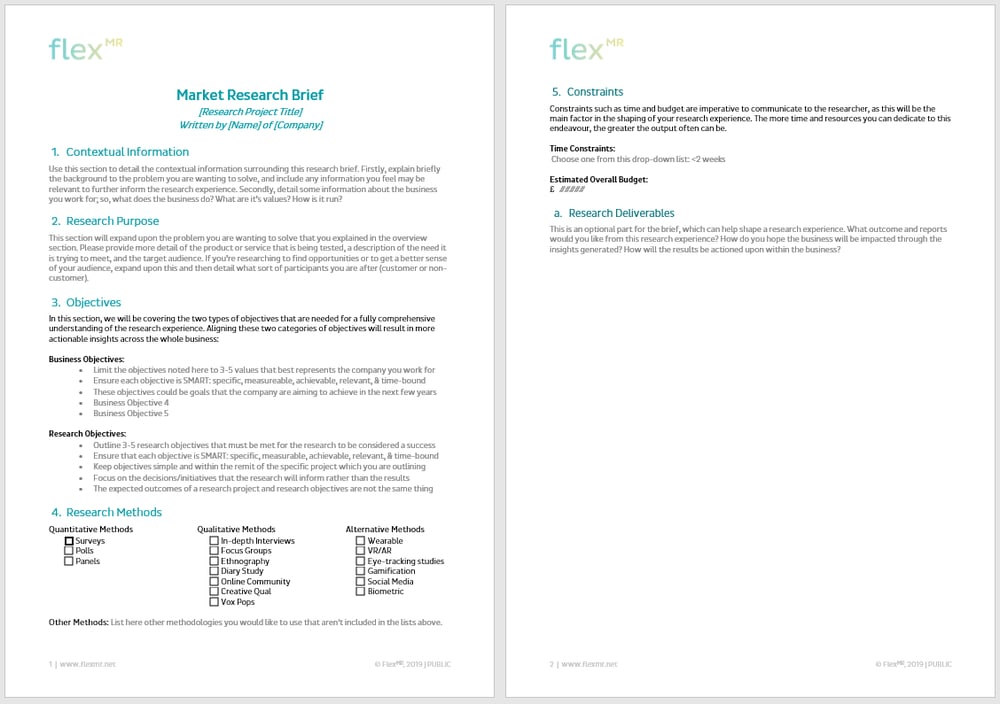
4. Research Methods
While this will also be subject to modification, an idea of what types of research methods the business might want to employ for this research experience will provide insights on a couple of things to a well-trained researcher. Firstly, it will indicate the business’ level of knowledge on market research, which will allow the researcher to adjust their tone, etc. to accommodate for any knowledge gaps that might be present.
Secondly, it will indicate what type of research that the business is looking to conduct (i.e. qualitative or quantitative, etc.), even if they don’t know it themselves. This section also serves the purpose of sparking a bit of research on the business’ end to see for themselves what options are available to them.
5. Business constraints
This is a relatively simple one. Constraints such as time and budget are imperative to communicate to the researcher, as this will be the main factor in the shaping of your research experience. Depending on whether a business is very constrained or loosely constrained will determine what types of research tasks should be employed, and how extravagant and dedicated a researcher can be in their pursuit of insights for the business.
a. Research Deliverables
Finally, this is an optional category of information that will help shape the research experience in both the formation of the research tasks and the research reports. One important question is, what actions would you want to take after receiving the insights from the research?
If the answer to this question depends on the tone of the insights, then what options do you see for how the results will be used within the business? Different agencies will offer different reporting options and it helps to know which you would like. So, what type of report would you like to receive? The answers to these questions help how the report and project are framed.
Free Template Example
Use this link to download our free market research brief template. This template contains editable sections that complies with the advice above, with brief guidance and tips on how to make the most out of your brief. This template is currently available in .docx format only, and will require a copy of Microsoft Word or an alternative text editor to be used.
About FlexMR
We are The Insights Empowerment Company. We help research, product and marketing teams drive informed decisions with efficient, scalable & impactful insight.
About Emily James
As a professional copywriter, Emily brings our global vision to life through a broad range of industry-leading content.
Stay up to date
You might also like....

Market Research Room 101: Round 2
On Thursday 9th May 2024, Team Russell and Team Hudson duelled in a panel debate modelled off the popular TV show Room 101. This mock-gameshow-style panel, hosted by Keen as Mustard Marketing's Lucy D...

Delivering AI Powered Qual at Scale...
It’s safe to say artificial intelligence, and more specifically generative AI, has had a transformative impact on the market research sector. From the contentious emergence of synthetic participants t...

How to Use Digital Ethnography and ...
In one way or another, we’ve all encountered social media spaces. Whether you’ve had a Facebook account since it first landed on the internet, created different accounts to keep up with relatives duri...

How to Write a Simple Project Brief: Template & Examples
Your sales team just sold a new project and handed off all the information they have to you on the shared drive. While they put a lot of good stuff in there, it would easily overwhelm your team and stakeholders—and they don’t have that kind of time to spare.
Now it’s up to you to figure out what needs to be pulled out and shared with your team so they understand the project’s most important parts. By doing this, you’ll get them up to speed quickly and allow them to see how they fit into the project.
The perfect place to put those key highlights? A project brief.
Let’s take a closer look at what a project brief is and how it’s used in project management.
What is a project brief?
A project brief is an easy-to-digest document that outlines the critical components of a project for your team and stakeholders. While a project plan details how a project will get done, a project brief defines the who , what , when , where , and why .
As the project manager, you’ll want to create a project brief right at the start of an engagement before your team gathers for an internal kick-off meeting. The length and format—and even the elements you include—will depend on the size and complexity of your project and client.
While you might be tempted to include all the good details you uncover from your sales team in your project brief, this isn’t the place for it. The key is to make it approachable enough for your team and stakeholders to understand without leaving any critical information out.
Challenge yourself to keep it to one page so people will actually want to reference it. After all, any info beyond that is up to you to track, not everyone else.
Project brief vs creative brief
Like a project brief, a creative brief is a document that outlines high-level details of a creative project. It focuses on the strategy and design aspects of the project and may include information about target audiences, competitive differentiation, strategic direction, messaging, and more.
If you’re managing a project that involves creative work, you’ll likely create both documents. The project brief will paint the broad strokes of your entire project, while the creative (or strategic) brief provides more specific direction for the creative portion of your project.
Learn how to write a creative brief, and download a free template.
Project brief vs project charter
You might also be wondering about the difference between a project brief and a project charter . Think of your project brief as a high-level summary of the project charter.
A project charter is longer, more formal, and goes into all the extra information you left out of the brief. Its goal is to outline all the project details and secure client approval. While it’s not the official project contract, it often serves as a scope contract between a project manager and their client and is a go-to reference when scope creep happens .
The project brief should align with your project charter but live as an abbreviated, less formal version that seeks to inform vs contract with approvals.
Your project might have both documents or just one. It really depends on what makes sense for your team, process, and project. I personally lean towards fewer documents and pages, but some projects and clients need more formality.
Learn how to create a project charter, and grab a free template.
What’s the purpose of a project brief ?
The project brief can serve many purposes. Here are 3 reasons a project brief is important in project management:
- It provides information and clarity. Outlining the who, what, when, where, and why of a project gets your team up to speed on the work they’ll soon be involved in. It also clarifies each person’s role in the project and how they can best contribute.
- It establishes a common understanding to mitigate risk and confusion. If you’re not doing a project charter, you can use the project brief as a sort of agreement. Review the brief together to confirm your scope, goals, and more—all while addressing any gray areas and red flags. Getting everyone on the same page helps reduce project risk and avoids wasting time in areas outside the project focus.
- It creates excitement and rallies the teams together. Sharing the project brief in a pre-kick-off meeting allows you to introduce everyone who will be involved in the work and establish a unified vision for the project. This goes a long way towards creating a “We’re all in this together” environment.
Who’s responsible for writing a project brief?
So who should create the project brief? Well, that depends on how your team is structured.
Ultimately, the project manager should own responsibility for the brief. That being said, your sales team or account manager might start filling out the template with the information they have as part of your sales to production hand-off process.
At the end of the day, though, it’s up to you as the project manager to ensure the brief is fully complete and that your team and stakeholders understand all aspects of it.
Lay a clear path to success with a visual plan that’s easy to understand, and keep everyone in sync with flexible workflows and team collaboration.
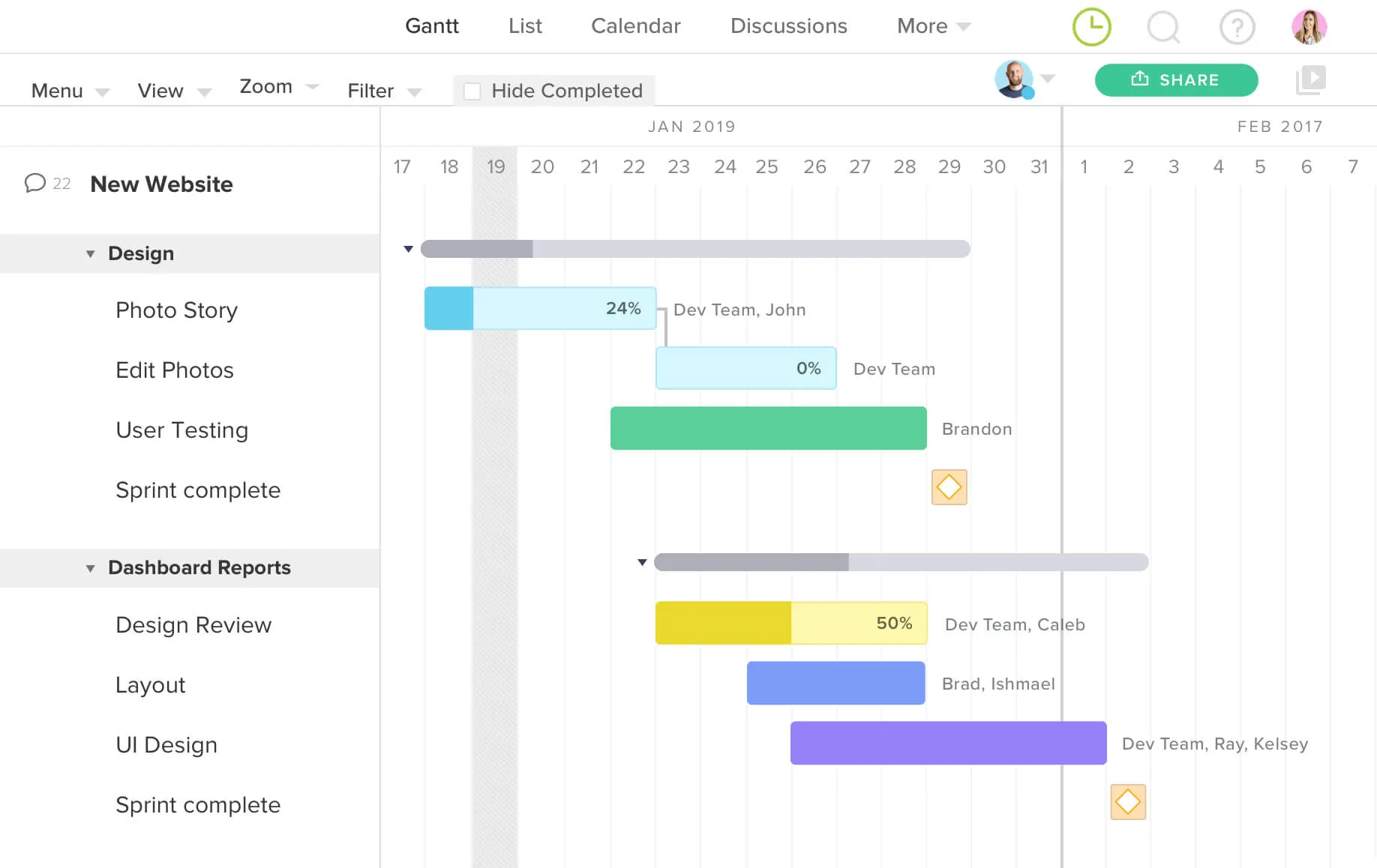
What elements should you include in a project brief?
As I noted, what you include in the project brief will depend on your team, client, and project complexity. Here are some common elements that typically make up a project brief:
- Brief description of the project
- Overview of the client/organization
- Project goals and/or success criteria
- Project team and stakeholders
- High-level timeline of major project milestones
Let’s walk through the basic steps for creating a project brief.
How to write a project brief with examples
The hardest part about writing a project brief is striking the right balance between information overload and giving team members something they’ll actually read and reference.
Do your best to keep it short, simple, and accessible, while ensuring the information you include is truly useful. These steps can help you focus on the details that matter most when creating a project brief.
1. Summarize the project and its purpose
Start with a short elevator pitch that outlines what the project is all about. Use this section to explain why the project is happening now and how it will provide value to the organization.
Here’s an example of what the project summary might look like for a website redesign brief:

2. Outline what the project needs to accomplish
It’s a whole lot easier to deliver a project win when everyone’s working toward the same goal. Show your team what success looks like by listing the top 3-5 goals the project must accomplish.
If you can, tie these project goals to business objectives. That way, your team understands how their work will impact the company as a whole.

3. Provide some background about the client
You don’t have to unpack your client’s whole backstory here. Instead explain who the project is for in 2-3 sentences.
Feel free to include any quick facts the team should know about your client’s organization or market as bullet points, like we’ve done in the sample below:

4. Introduce key players and their project roles
Your project brief is a great place to give everyone a quick rundown of who’s who on the project. I recommend breaking these introductions down into 2 groups:
- Project team: List each core team member’s name and role, and include an image to help clients put faces with names more easily. Noting percent allocation will give the client a clear picture of how much time each team member has dedicated to this project.
- Key stakeholders: List the name, title, and project role for each key stakeholder on your project. Be sure to identify the decision-maker and main point of contact for your client if those roles have been decided. Stakeholder photos may be tough to come by, so don’t sweat it if you can’t include them in your project brief.
You can see what these sections might look like in the project brief example highlighted below:

5. List key deliverables with dates
You may not be ready to commit to a full-blown project plan at this stage, but it’s important to sketch out a timeline for major deliverables. Aim for 5-10 items to keep your timeline high-level.
Many people process images better than text, so I recommend creating a quick, visual timeline in a project management tool like TeamGantt . Simply add key deliverables as milestones on your gantt chart, then throw a screenshot of that timeline into your project brief.
Before you wrap up this section, be sure to mention any major out-of-scope items and/or project breaks. In our sample project brief, we called out-of-scope items out in a different color so they don’t get overlooked.

6. Include any other important items of note
Finally, add any key notes that can provide clarification or insight about the project. You might outline risks with mitigation strategies , possible phase 2 items, or recent shifts in the marketplace.
This section of the project brief will likely be a group of random items, and that’s just fine. You just don’t want to lose anything that could spark an important conversation or idea for the project.
Here are a couple of additional notes we included in our sample project brief:

Project brief example
This sample project brief gives shows you what your final product might look like when all the elements come together.

Tips to make your project brief more effective
Now that you’ve got the basics down, let’s review a few ways you can add even more value to your project brief.
Use a template to save time
Your time is best spent thoughtfully adding content to your project brief—not messing with a tool and fixing formatting.
Creating a project brief template is an easy way to make your process repeatable. This saves you and your fellow project managers time, while establishing brand consistency across your organization.
We created a free project brief template to help you get started more quickly. Choose between landscape or portrait format, then make a copy of your own in Google Docs (or download it as a Word document). Simply drop in your logo, and customize the details to fit your project.
- Project brief template (Landscape format)
- Project brief template (Portrait format)
Want a project brief that’s visually engaging? Consider using a tool like Miro or Figma to build and brand your project brief.
Just make sure everyone has access to whatever tool you use and feels comfortable editing in it.
Do the work
Let’s be honest, as project managers, we’re often overloaded with projects and to-dos—especially at the start of a new project. You might be inclined to just fill in the blanks and call it a day. But that’s defeating the point.
The thing that really brings value to a project brief is the experience and thought you put into it. Consider who the client is, what the project’s about, and what information will help your team get to work with confidence.
Remember: This document sets a foundation for the project. It’s worth spending time to get this right.
Use all your resources
As a project manager, you have access to lots of resources—whether it’s the sales team, new client, RFP, project proposal , CRM, etc.
Take time to talk to the right people and dig through all the documentation. Most existing documents will likely be set aside as you and your team start creating new ones, so make sure key info from the past comes forward and gets shared.
Adjust your project brief’s format and contents as needed
Your project brief will likely evolve over time as you incorporate this document in your process. You may start to see that some information isn’t helpful while other important details are missing.
Revisit the brief’s value every couple of projects to ensure you’re making the most out of its use.
Build a free timeline for your project brief
TeamGantt makes it easy to create a simple timeline for your project brief so everyone knows when to expect major project deliverables.
When you’re ready to draft a comprehensive plan, just pick up where you left off, and schedule all your tasks. You’ll have all the features you need to keep your team in sync and ensure projects finish on time and on budget.
Try TeamGantt for free today!
About the author: Lynn Winter
Lynn is a freelance Digital Strategist who combines 20+ years of experience in content strategy, user experience, and project management to bring a holistic approach to her work. She has spoken at numerous local and national conferences and hosts an annual conference for Digital Project Managers called Manage Digital ( http://managedigital.io/ ). You can connect with her at lynnwintermn.com .

Popular searches
- How to Get Participants For Your Study
- How to Do Segmentation?
- Conjoint Preference Share Simulator
- MaxDiff Analysis
- Likert Scales
- Reliability & Validity
Request consultation
Do you need support in running a pricing or product study? We can help you with agile consumer research and conjoint analysis.
Looking for an online survey platform?
Conjointly offers a great survey tool with multiple question types, randomisation blocks, and multilingual support. The Basic tier is always free.
Catherine Chipeta
Monthly newsletter.
Get the latest updates about market research, automated tools, product testing and pricing techniques.
A good market research brief helps agencies lead successful projects. Learn what to include and how to write a detailed brief with our template guide.
A market research brief is a client document outlining all the relevant information that a research agency needs to understand the client’s specific research needs to propose the most suitable course of action.
A clear, informed brief will ensure the market researcher can deliver the most effective research possible. It also streamlines the project by reducing the need for back and forth between your company and the researcher. A good brief will leave no confusion and provide a meaningful framework for you and the researcher, maximising the accuracy and reliability of insights collected.
Start your project faster with our market research brief template!
In this article, we’ve broken down the key components of a well-written brief, with examples. Using this template guide, you can confidently equip the researcher with the right information to deliver exemplary research for your next project.
Business Background/ Project Background
This section of the brief introduces your company to the market researcher, giving them a more informed overview of your brand, product/service, and target market. You should provide all available context to ensure you and the researcher are on the same page with the project.
Relevant information to add in this section includes: company details, company mission/vision, industry status and trends, market performance history, competitive context, any existing research.
Business Objectives/ Marketing Objectives
Your business objectives/marketing objectives should answer why you are being asked to conduct the research. The researcher should be able to grasp the existing problems/issues your company is looking to address in the research.
For example, this could involve sales, competition, customer satisfaction, or product innovation, to name a few.
Research Objectives
Research objectives address the specific questions you would like the research to cover, including what insights you wish to gain. This is where you should detail what actions your company is planning to take based on the research you are commissioning.
Your research objective is one of the most important elements of your brief, as it dictates how your study will be conducted and the quality of results.
Target Market
Who will this research focus on? This is where you should state respondents’ demographic and profiling information, along with any pre-existing segments you want to target. Be specific, but also be aware that the more restrictive the criteria are, the higher the sample cost will be. Extensive limitations are also realistically harder to meet.
For example:
- Market: Canada
- Sample size: 200 – 1000
- Demographics: Household income of $150k and above a year
- Markets: Malaysia (priority), Thailand, Singapore
- Sample size: N=200 (Product Variant Selector) + N=500 (Conjoint)
- Demographics: 16 – 50 years old
- National representation: Age, gender and location
- Target definition: Bought electronics online in the past 12 months
- Reads on: 16 – 30-year olds vs. 31 – 50-year olds
- Market: South America
- Sample size: 1800
- Target definition: Main and joint grocery buyers
- 5 target groups: Income, urban/rural, age, family status, shopping frequency (divide each into 3 subgroups, e.g. low, medium, high).
Action Standards/ Decision Rules
Action standards outline which criteria will determine the decisions you make following research. These should detail specific numerical scores and any company benchmarks which need to be met in your research results for decision-making to go ahead. Clear and detailed action standards will allow you to make decisions faster and more confidently following research.
Nestlé’s 60/40 action standard which prioritises preference and nutrition, by aiming “to make products that achieve at least 60% consumer taste preference with the added ‘plus’ of nutritional advantage”.
Pricing is seen as credible by at least 40% of the target market.
Product has at least 50% acceptance from the target market.
Methodology
You should only include methodology if you are certain of the approach you want to take. If you do not know which methodology you should use, leave this section blank for agency recommendations.
Monadic test : Monadic testing introduces survey respondents to individual concepts, products in isolation. It is usually used in studies where independent findings for each stimulus are required, unlike in comparison testing, where several stimuli are tested side-by-side. Each product/concept is displayed and evaluated separately, providing more accurate and meaningful results for specific items.
Discrete choice modelling : Sometimes referred to as choice-based conjoint, discrete choice is a more robust technique consistent with random utility theory and has been proven to simulate customers’ actual behaviour in the marketplace. The output on relative importance of attributes and value by level is aligned to the output from conjoint analysis (partworth analysis).
Qualitative research : Qualitative forms of research focus on non-numerical and unstructured data, such as participant observation, direct observation, unstructured interviews, and case studies.
Quantitative research : Numbers and measurable forms of data make up quantitative research, focusing on ‘how many’, ‘how often’, and ‘how much’, e.g. conjoint analysis , MaxDiff , Gabor-Granger , Van Westendorp .
Deliverables
Deliverables should clearly outline project expectations – both from your company and the agency. This should cover who is responsible for everything required to undertake research, including survey inputs and outputs, materials, reporting, reviewing, and any additional requirements.
- PowerPoint presentation
- Crosstabs of data
- Raw datasets
- Excel simulator
- Online dashboard
- “Typing tool” for future research
Timing and Cost
Timing covers the due dates for key milestones of your research project, most importantly, for your preliminary and final reports. Cost should include your project budget, along with any potential additional costs/constraints.
Contacts and Responsibilities
This section states all stakeholders involved in the project, their role and responsibilities, and their contact details. You should ensure that these are easy to locate on your brief, for quick reference by the agency and easier communication.
Ready-to-use market research brief template with examples
Start your research project faster and get better results. Using this template, you can confidently equip the researcher with the right information to deliver exemplary research for your next project.
Read these articles next:
Feature placement matrix calculator.
Try out and generate a Feature Placement Matrix within seconds by uploading your own data set. Let's get started!
Gabor-Granger or Van Westendorp?
With so many pricing research methodologies out there, how do you know which is the right one for you?
How to perform smart sampling and data checking?
With 5,000+ projects performed on the platform, Conjointly market research experts have compiled common concerns regarding sampling and data checking and provide their suggestions.
Which one are you?
I am new to conjointly, i am already using conjointly, cookie consent.
Conjointly uses essential cookies to make our site work. We also use additional cookies in order to understand the usage of the site, gather audience analytics, and for remarketing purposes.
For more information on Conjointly's use of cookies, please read our Cookie Policy .
Do you want to be updated on new features from Conjointly?
We send occasional emails to keep our users informed about new developments on Conjointly , such as new types of analysis and features.
Subscribe to updates from Conjointly
You can always unsubscribe later. Your email will not be shared with other companies.
- Scroll to top
- Light Dark Light Dark

Cart review
No products in the cart.
Research Brief Format: Essential Guide for Clear & Concise Reports
- Author Survey Point Team
- Published February 28, 2024

Research brief format are invaluable tools for distilling complex research findings into an easily digestible format for busy stakeholders. A well-structured research brief gets the most important information in front of decision-makers, policymakers, and other non-technical audiences. This guide breaks down the essential elements that make a research brief impactful and easy to understand.
Delving into the world of research briefs requires finesse and a deep understanding of the essentials. In this guide, we unravel the intricacies of the [Research Brief Format: Essential Guide for Clear & Concise Reports]. From the foundation to advanced strategies, we’ve got you covered. Let’s embark on this journey to elevate your reporting skills.
Table of Contents
Research Brief Basics
Definition and Purpose: A research brief is a short, targeted summary of a research study or project. Its primary purposes are to:
- Inform decision-makers who might not have time for in-depth reports.
- Influence policy by highlighting key research outcomes.
- Shape public opinion or action regarding a specific issue.
Target Audience: Research briefs are written for a non-specialist audience. This generally includes policymakers, stakeholders, or the general public without the technical background to decipher full research reports.
Key Differences from a Research Report:
Length: Research briefs are concise (often 2-4 pages), while reports are much longer.
Focus: Briefs highlight key conclusions and recommendations, while reports present detailed methodology, data, and in-depth analysis
Essential Elements of a Research Brief Format
Title: Concisely and accurately reflects the research focus.
Executive Summary: A few sentences or a short paragraph outlining the absolute essentials: problem, key findings, and main recommendations.
Background/Problem Statement: Briefly explain the issue the research addressed and why it matters.
Research Questions: State the specific questions your research sought to answer.
Methodology: A high-level summary of your research methods (e.g., surveys, experiments, etc.). Avoid excessive technical detail.
Key Findings: Present main findings as clear bullet points or short statements.
Recommendations: Offer actionable recommendations based directly on your findings.
Limitations: Briefly acknowledge factors that might limit the generalizability of your findings.
Visual Aids (Optional): A simple graph or chart can powerfully illustrate the most important finding.
Tips for Writing Clear & Concise Research Brief Format
Plain Language: Ditch the jargon and complex terminology!
Focused: Include only the most essential information for your target audience.
Action-oriented: Clearly emphasize the implications of your findings and provide practical recommendations. What is the ideal length for a research brief? A research brief’s length depends on the complexity of the topic. However, aiming for a concise document of 2-3 pages is often effective.
Frequently Asked Questions
How crucial are LSI keywords in a research brief? LSI keywords enhance the visibility and relevance of your research brief, making it a vital element for a successful report.
Can visual aids replace detailed explanations? While visual aids are impactful, they should complement, not replace, detailed explanations. Balance is key for an effective research brief.
Is there a specific structure to follow in a research brief? Yes, a well-structured research brief typically includes an introduction, methodology, findings, and conclusion. Adhering to this format ensures clarity.
How can I scope my research effectively? Define the scope by clearly stating the objectives, limitations, and expected outcomes of your research. This provides a clear roadmap for your study.
Should I include recommendations in my research brief? Yes, offering actionable recommendations adds value to your research brief, demonstrating its practical implications.
A well-formatted research brief is a powerful communication tool . It can shape how your research is understood and applied by those in positions to make a difference. Use this guide to create briefs that are both informative and persuasive.
Survey Point Team

Check out our new Consent management feature here
- Case Studies
- Book a Demo
Market Research Brief Template
Market research plays a crucial role in the success of any business. By providing valuable insights into customers, competitors, and market trends, it helps companies make informed decisions and develop effective strategies. A well-designed market research brief is the foundation of any successful research project. It helps define the objectives, scope, and methodologies of the research, ensuring that the right information is collected and analyzed to meet the organization's needs.
1. Introduction to Market Research Briefs
Before delving into the details of market research briefs, let's first understand what they are and why they are important.
What is a market research brief?
A market research brief is a document that outlines the objectives, scope, methodologies, and timelines for a research project. It acts as a roadmap for the research team, guiding them through the process of data collection, analysis, and reporting.
Importance of market research briefs
Market research briefs are essential for several reasons. Firstly, they help clarify the purpose of the research and ensure that it aligns with the organization's goals. By clearly defining the research objectives, they provide a clear direction for the research team, ensuring that everyone is on the same page.
Secondly, market research briefs help identify the target audience and market segment. Understanding who the research is meant to serve allows the team to design appropriate data collection methods and analyze the results in a way that is relevant and meaningful to the intended audience.
Lastly, market research briefs help allocate resources and budget effectively. By clearly identifying the research goals and methodologies upfront, organizations can allocate the necessary resources, whether it be time, money, or personnel, to execute the research in the most efficient and cost-effective manner.
Objective and purpose of the research
The first step in creating a market research brief is to clearly articulate the research objective and purpose. This section should outline what the organization hopes to achieve through the research, whether it be gaining insights into customer preferences, understanding market trends, or assessing the viability of a new product or service.
By defining the objective and purpose, the research team can focus their efforts on collecting the right information and analyzing it in a way that addresses the organization's needs.
Target audience and market segment
Identifying the target audience is a critical step in market research. This section of the brief should provide a detailed description of the target audience and the specific market segment the research aims to study.
Understanding the target audience allows the research team to tailor their data collection methods and analysis techniques to gather meaningful insights. It helps ensure that the research findings are relevant and applicable to the intended audience.
Research methodology and approach
Choosing the right research methodology and approach is essential in obtaining accurate and reliable results. This section of the market research brief should outline the proposed research methods, whether it be quantitative, qualitative, or a combination of both.
Additionally, it should discuss the data collection techniques, such as surveys, interviews, observations, or focus groups, that will be used to gather information from the target audience. The brief should also mention any specific tools or software that will be utilized to assist in data collection and analysis.
Identifying the research goals
In this section, the market research brief should outline specific research goals that align with the research objectives. These goals should be measurable and clearly defined, allowing the research team to track progress and evaluate the success of the research project.
For example, if the research objective is to understand customer preferences, a research goal could be to identify the key factors that drive purchasing decisions. By setting clear research goals, the team can focus their efforts on collecting the necessary data and analyzing it in a way that addresses these goals.
Formulating specific research questions
Formulating specific research questions helps guide the data collection process and provides a framework for analyzing the findings. This section of the market research brief should outline the specific research questions that the research team aims to answer.
Research questions should be clear, concise, and directly related to the research objectives. They should focus on gathering information that will help the organization make informed decisions or develop effective strategies.
Conducting demographic analysis
Demographic analysis involves studying the characteristics of a population, such as age, gender, income, and education level. This section of the market research brief should outline how demographic analysis will be conducted and why it is important.
By analyzing demographic data, organizations can gain insights into their target audience's preferences, behaviors, and needs. This information can then be used to tailor marketing strategies, product development, and customer experiences to better meet the needs of the target market.
Identifying customer preferences and needs
Understanding customer preferences and needs is crucial for any business. This section of the market research brief should outline the methods that will be used to identify and analyze customer preferences and needs, such as surveys, interviews, or focus groups.
By gathering this information, organizations can determine what their customers value most and what factors influence their purchasing decisions. This knowledge can then be used to develop products and services that meet customer needs and preferences, ultimately leading to increased customer satisfaction and loyalty.
Quantitative research methods
Quantitative research involves gathering numerical data and analyzing it statistically. This section of the market research brief should outline the quantitative research methods that will be used, such as surveys or experiments, and explain why they are appropriate for the research objectives.
Quantitative research provides valuable insights into market trends, customer behaviors, and the effectiveness of marketing campaigns. By collecting and analyzing numerical data, organizations can make data-driven decisions that have a higher chance of success.
Qualitative research methods
Qualitative research involves gathering non-numerical data, such as opinions, perceptions, and experiences, and analyzing it in a subjective manner. This section of the market research brief should outline the qualitative research methods that will be used, such as interviews or focus groups, and explain why they are appropriate for the research objectives.
Qualitative research provides a deeper understanding of customer motivations, attitudes, and perceptions. It allows organizations to uncover valuable insights that may not be captured by quantitative data alone and provides a more holistic view of the target market.
Creating a timeline and milestones
A well-defined timeline is essential for managing the research project effectively. This section of the market research brief should outline the key milestones and deadlines for each phase of the research project.
By creating a timeline, the research team can ensure that the project stays on track and that all activities are completed within the specified timeframes. It also allows stakeholders to monitor progress and make adjustments as necessary.
Allocating resources and budget
Allocating resources and budget is a crucial aspect of any research project. This section of the market research brief should outline the resources, whether it be personnel, equipment, or software, that will be needed to execute the research project successfully.
Additionally, it should include a budget breakdown that outlines the estimated costs for each phase of the research project. By allocating resources and budget effectively, organizations can ensure that the research project can be executed without any unnecessary delays or constraints.
Data collection techniques
This section of the market research brief should outline the specific data collection techniques that will be used, such as surveys, interviews, or observation. It should also discuss the rationale behind selecting these techniques and explain how they will help gather the necessary information.
Choosing the right data collection techniques is crucial for obtaining accurate and reliable data. Each technique has its strengths and limitations, and understanding these factors will help ensure that the research findings are robust and meaningful.
Data analysis methods
Data analysis is a critical step in converting raw data into actionable insights. This section of the market research brief should outline the specific data analysis methods that will be used, such as statistical analysis, content analysis, or thematic coding.
The chosen data analysis methods should align with the research objectives and the type of data collected. They should provide a structured approach to analyzing and interpreting the data, allowing the research team to draw meaningful conclusions.
Drawing conclusions from the data
In this section of the market research brief, the research team should outline how they will draw conclusions from the data collected. This may involve identifying patterns, trends, or correlations in the data and using them to make informed judgments or decisions.
Conclusions should be based on evidence and supported by the data collected during the research project. By drawing sound conclusions, organizations can make informed decisions that have a higher likelihood of success.
Presenting research findings effectively
Presenting research findings effectively is essential to ensure that the insights gained from the research are understood and utilized by the intended audience. This section of the market research brief should outline how the research findings will be presented, whether it be through written reports, presentations, or visual representations.
The chosen presentation format should be clear, concise, and visually appealing, facilitating easy comprehension and interpretation of the research findings. It should highlight the key insights and their implications for the organization.
Translating research insights into actionable strategies
The ultimate goal of market research is to translate the insights gained from the research into actionable strategies. This section of the market research brief should outline how the research insights will be used to inform decision-making and strategy development.
By connecting the research findings to specific actions and strategies, organizations can leverage the insights gained to improve their products, services, marketing initiatives, and overall business performance.
Monitoring and evaluating the outcomes
Monitoring and evaluating the outcomes of the research is essential to assess the effectiveness of the research project and identify areas of improvement. This section of the market research brief should outline how the outcomes will be monitored and evaluated.
By tracking the outcomes and evaluating the impact of the research, organizations can continuously improve their research practices and ensure that future research projects are even more effective.
Recap of the market research brief template
To recap, a market research brief is a comprehensive document that outlines the objectives, scope, methodologies, and timelines for a research project. It acts as a roadmap for the research team, guiding them through the process of data collection, analysis, and reporting.
By following the structure outlined in this market research brief template, organizations can ensure that their research projects are well-planned, executed effectively, and provide valuable insights that drive informed decision-making.
Final thoughts on the importance of market research briefs
Market research briefs play a crucial role in ensuring the success of market research projects. They provide a clear roadmap for the research team, guiding them through the process of data collection, analysis, and reporting. By defining the research objectives, scope, and methodologies upfront, market research briefs help ensure that the right information is collected and analyzed to meet the organization's needs.
Additionally, market research briefs help allocate resources and budget effectively, identify the target audience and market segment, and translate research insights into actionable strategies. They lay the foundation for evidence-based decision-making and foster a deeper understanding of customers, competitors, and market trends.
In conclusion, market research briefs are an essential tool for organizations seeking to gain a competitive edge in today's fast-paced business environment. By investing time and effort into creating well-designed market research briefs, organizations can unlock valuable insights that inform their strategies and drive their success.
Have a language expert improve your writing
Run a free plagiarism check in 10 minutes, generate accurate citations for free.
- Knowledge Base
- Starting the research process
- How to Write a Research Proposal | Examples & Templates
How to Write a Research Proposal | Examples & Templates
Published on October 12, 2022 by Shona McCombes and Tegan George. Revised on November 21, 2023.

A research proposal describes what you will investigate, why it’s important, and how you will conduct your research.
The format of a research proposal varies between fields, but most proposals will contain at least these elements:
Introduction
Literature review.
- Research design
Reference list
While the sections may vary, the overall objective is always the same. A research proposal serves as a blueprint and guide for your research plan, helping you get organized and feel confident in the path forward you choose to take.
Table of contents
Research proposal purpose, research proposal examples, research design and methods, contribution to knowledge, research schedule, other interesting articles, frequently asked questions about research proposals.
Academics often have to write research proposals to get funding for their projects. As a student, you might have to write a research proposal as part of a grad school application , or prior to starting your thesis or dissertation .
In addition to helping you figure out what your research can look like, a proposal can also serve to demonstrate why your project is worth pursuing to a funder, educational institution, or supervisor.
| Show your reader why your project is interesting, original, and important. | |
| Demonstrate your comfort and familiarity with your field. Show that you understand the current state of research on your topic. | |
| Make a case for your . Demonstrate that you have carefully thought about the data, tools, and procedures necessary to conduct your research. | |
| Confirm that your project is feasible within the timeline of your program or funding deadline. |
Research proposal length
The length of a research proposal can vary quite a bit. A bachelor’s or master’s thesis proposal can be just a few pages, while proposals for PhD dissertations or research funding are usually much longer and more detailed. Your supervisor can help you determine the best length for your work.
One trick to get started is to think of your proposal’s structure as a shorter version of your thesis or dissertation , only without the results , conclusion and discussion sections.
Download our research proposal template
Prevent plagiarism. Run a free check.
Writing a research proposal can be quite challenging, but a good starting point could be to look at some examples. We’ve included a few for you below.
- Example research proposal #1: “A Conceptual Framework for Scheduling Constraint Management”
- Example research proposal #2: “Medical Students as Mediators of Change in Tobacco Use”
Like your dissertation or thesis, the proposal will usually have a title page that includes:
- The proposed title of your project
- Your supervisor’s name
- Your institution and department
The first part of your proposal is the initial pitch for your project. Make sure it succinctly explains what you want to do and why.
Your introduction should:
- Introduce your topic
- Give necessary background and context
- Outline your problem statement and research questions
To guide your introduction , include information about:
- Who could have an interest in the topic (e.g., scientists, policymakers)
- How much is already known about the topic
- What is missing from this current knowledge
- What new insights your research will contribute
- Why you believe this research is worth doing
Receive feedback on language, structure, and formatting
Professional editors proofread and edit your paper by focusing on:
- Academic style
- Vague sentences
- Style consistency
See an example

As you get started, it’s important to demonstrate that you’re familiar with the most important research on your topic. A strong literature review shows your reader that your project has a solid foundation in existing knowledge or theory. It also shows that you’re not simply repeating what other people have already done or said, but rather using existing research as a jumping-off point for your own.
In this section, share exactly how your project will contribute to ongoing conversations in the field by:
- Comparing and contrasting the main theories, methods, and debates
- Examining the strengths and weaknesses of different approaches
- Explaining how will you build on, challenge, or synthesize prior scholarship
Following the literature review, restate your main objectives . This brings the focus back to your own project. Next, your research design or methodology section will describe your overall approach, and the practical steps you will take to answer your research questions.
| ? or ? , , or research design? | |
| , )? ? | |
| , , , )? | |
| ? |
To finish your proposal on a strong note, explore the potential implications of your research for your field. Emphasize again what you aim to contribute and why it matters.
For example, your results might have implications for:
- Improving best practices
- Informing policymaking decisions
- Strengthening a theory or model
- Challenging popular or scientific beliefs
- Creating a basis for future research
Last but not least, your research proposal must include correct citations for every source you have used, compiled in a reference list . To create citations quickly and easily, you can use our free APA citation generator .
Some institutions or funders require a detailed timeline of the project, asking you to forecast what you will do at each stage and how long it may take. While not always required, be sure to check the requirements of your project.
Here’s an example schedule to help you get started. You can also download a template at the button below.
Download our research schedule template
| Research phase | Objectives | Deadline |
|---|---|---|
| 1. Background research and literature review | 20th January | |
| 2. Research design planning | and data analysis methods | 13th February |
| 3. Data collection and preparation | with selected participants and code interviews | 24th March |
| 4. Data analysis | of interview transcripts | 22nd April |
| 5. Writing | 17th June | |
| 6. Revision | final work | 28th July |
If you are applying for research funding, chances are you will have to include a detailed budget. This shows your estimates of how much each part of your project will cost.
Make sure to check what type of costs the funding body will agree to cover. For each item, include:
- Cost : exactly how much money do you need?
- Justification : why is this cost necessary to complete the research?
- Source : how did you calculate the amount?
To determine your budget, think about:
- Travel costs : do you need to go somewhere to collect your data? How will you get there, and how much time will you need? What will you do there (e.g., interviews, archival research)?
- Materials : do you need access to any tools or technologies?
- Help : do you need to hire any research assistants for the project? What will they do, and how much will you pay them?
If you want to know more about the research process , methodology , research bias , or statistics , make sure to check out some of our other articles with explanations and examples.
Methodology
- Sampling methods
- Simple random sampling
- Stratified sampling
- Cluster sampling
- Likert scales
- Reproducibility
Statistics
- Null hypothesis
- Statistical power
- Probability distribution
- Effect size
- Poisson distribution
Research bias
- Optimism bias
- Cognitive bias
- Implicit bias
- Hawthorne effect
- Anchoring bias
- Explicit bias
Once you’ve decided on your research objectives , you need to explain them in your paper, at the end of your problem statement .
Keep your research objectives clear and concise, and use appropriate verbs to accurately convey the work that you will carry out for each one.
I will compare …
A research aim is a broad statement indicating the general purpose of your research project. It should appear in your introduction at the end of your problem statement , before your research objectives.
Research objectives are more specific than your research aim. They indicate the specific ways you’ll address the overarching aim.
A PhD, which is short for philosophiae doctor (doctor of philosophy in Latin), is the highest university degree that can be obtained. In a PhD, students spend 3–5 years writing a dissertation , which aims to make a significant, original contribution to current knowledge.
A PhD is intended to prepare students for a career as a researcher, whether that be in academia, the public sector, or the private sector.
A master’s is a 1- or 2-year graduate degree that can prepare you for a variety of careers.
All master’s involve graduate-level coursework. Some are research-intensive and intend to prepare students for further study in a PhD; these usually require their students to write a master’s thesis . Others focus on professional training for a specific career.
Critical thinking refers to the ability to evaluate information and to be aware of biases or assumptions, including your own.
Like information literacy , it involves evaluating arguments, identifying and solving problems in an objective and systematic way, and clearly communicating your ideas.
The best way to remember the difference between a research plan and a research proposal is that they have fundamentally different audiences. A research plan helps you, the researcher, organize your thoughts. On the other hand, a dissertation proposal or research proposal aims to convince others (e.g., a supervisor, a funding body, or a dissertation committee) that your research topic is relevant and worthy of being conducted.
Cite this Scribbr article
If you want to cite this source, you can copy and paste the citation or click the “Cite this Scribbr article” button to automatically add the citation to our free Citation Generator.
McCombes, S. & George, T. (2023, November 21). How to Write a Research Proposal | Examples & Templates. Scribbr. Retrieved August 15, 2024, from https://www.scribbr.com/research-process/research-proposal/
Is this article helpful?
Shona McCombes
Other students also liked, how to write a problem statement | guide & examples, writing strong research questions | criteria & examples, how to write a literature review | guide, examples, & templates, get unlimited documents corrected.
✔ Free APA citation check included ✔ Unlimited document corrections ✔ Specialized in correcting academic texts
A Guide to Project Briefs: What They Are and How to Write One
By Kate Eby | August 10, 2022
- Share on Facebook
- Share on LinkedIn
Link copied
A project brief is helpful for sharing high-level project details with your stakeholders. We’ll teach you the best practices for writing one and how they differ from other, similar documents.
In this article, you’ll learn how to write a project brief and find helpful tips and best practices , as well as a downloadable template starter kit to get you up and running.
What Is a Project Brief?
A project brief is a short summary of the basic elements of a project. A brief allows teams to share project goals, strategies, and timelines with stakeholders. A brief should be a high-level overview and leave out unnecessary details.
A project brief is not as detailed as a project plan, but it includes similar information. For this reason, project managers should create a brief only after they’ve finalized the details of their project. Your brief acts as a straightforward summary of your project plan and is intended for clients and stakeholders. Think of the brief as a sound bite taken from a larger presentation.
Project briefs will vary in length but will generally be somewhere between one paragraph and one page long. A brief should always be as up to date as possible and be refreshed if and when project details change.

What Is the Purpose of a Project Brief?
Project managers use project briefs to share the most essential information with clients and stakeholders. A brief answers broad questions about project goals, timing, and strategy. It should not include every detail from the project plan.
A project brief is a snapshot of more complicated documents, such as project plans . Often, stakeholders only need to know what the team aims to accomplish and how long it will take. Briefs can be useful when communicating with clients for the same reason: Clients don’t necessarily need all the details about how their request will be carried out; they just need the broad strokes.
A project brief can also be adapted for use in presentations or kickoff meetings . Use them to summarize a project quickly and condense information into a few bullets on a single slide. Rewrite your brief in the past tense to create a testimonial or quick case study of completed projects, and share it with potential clients or investors.
Who Writes a Project Brief?
The project manager writes a brief after finalizing certain project details. They should work with the team and stakeholders to determine the goals, timing, and strategy of the project. Then they can summarize them in a project brief.
Before writing a project brief, you must know certain details about the project. You should know the goals of the project, how the team plans to achieve those goals, the value the project will add to the company, and the projected start and end dates.
Project Brief Elements
The three major elements of a project brief are a project overview, a goal statement, and an estimated timeline. A brief might also include background information, success metrics, and the project’s target market.
While the contents of a project brief might change based on your stakeholder's priorities and the size of the project, all project briefs should include the following elements:
- Overview: The project overview summarizes what the project entails, the problems it hopes to solve, and how the team plans to solve them. Outline the efforts needed to complete the project, as well as the strategies and project management methodology you will use to structure the project.
- Goals: Your brief should concretely state the project’s objective , including all goals and deliverables.
- Timeline: Include a projected start and end date for the project, as well as the predicted timing of major project phases and deliverables.
For larger projects or for certain audiences, you might also want to include the following elements in your project brief:
- Necessary Background Information: For an audience that may not be familiar with your team or your company, it might be worth providing background information on the project. Explain the story: Tell the audience why you are taking on the project and what problems it will solve. If it is related to previous or ongoing projects or product lines, include a sentence or two explaining those as well.
- Success Metrics: A project brief might be a good place to define specific metrics for a project, especially if the project is a new undertaking for the company.
- Target Audience: Creative and marketing projects should always highlight the target audience in a project brief, but other types of projects might benefit from doing this as well.
- Budget Information: Depending on how you are using your project brief and who your stakeholders are, you might also include a summary of the budget for your project.
How to Write a Project Brief
To write a project brief, summarize your project overview, timeline, and scope statement in a single page. You might also want to include success metrics and background information, as well as identify your target audience.
A project brief is a short document and should be between a single paragraph and a single page in length. Separate information into labeled sections, and write simply and clearly so that anyone can understand. If your brief is digital, include links to more detailed project documents, such as your project plan and project schedule . You might consider using a project brief template to get up and running quickly.
To create your own project brief, follow the steps below:
- Finalize Your Project Plan: Your project brief requires information from your project plan, so you should complete your plan first. Once you finalize your plan, which includes a project overview, schedule, and scope statement, you can begin summarizing this information in your project brief.
- Start with Identifying Information: At the top of your brief, write the name of the project, the name of the project manager, the members of the team, and the key stakeholders and clients. If your brief is digital, include a link to your communication plan .
- Write a Short Project Overview: Give the reader an overview of the project and the value it will add. For larger projects, you might include necessary background information and success metrics. If the project is customer-facing, identify your target audience.
- Identify the Project Goals: State the project’s goals, deliverables, and expected outcomes.
- Summarize Your Schedule: Give the reader an idea of the timeframe of your project. Identify the project’s start and end dates, as well as any expected deadlines for major project phases and deliverables.
- Consider Including Additional Elements: If your sponsors or stakeholders have asked for additional information to be included in your brief, make sure to do so. Additional items might include budget information, background information on the company or project, or any other project details that may be helpful to a casual reader.
- Share Additional Resources: Give readers the ability to find out more information. Include links to your project plan, team dashboards, and schedules when relevant. This will limit the time you spend fielding questions from stakeholders who want to learn more.
Project Brief Example
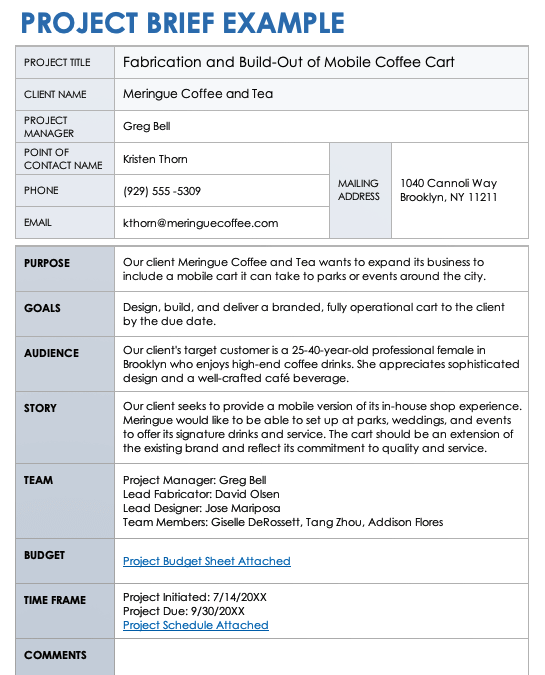
Download a Project Brief Example for Microsoft Excel | Microsoft Word | Google Docs | Google Sheets
This project brief example template is pre-filled with sample text to help contextualize the information included in a brief. This single-page template is completely editable and customizable so that you can include all the information you need in your project brief. It includes spaces to insert an overview of the purpose and goals of the project, timeframe and budget information, and additional comments and links.
Project Brief Starter Kit
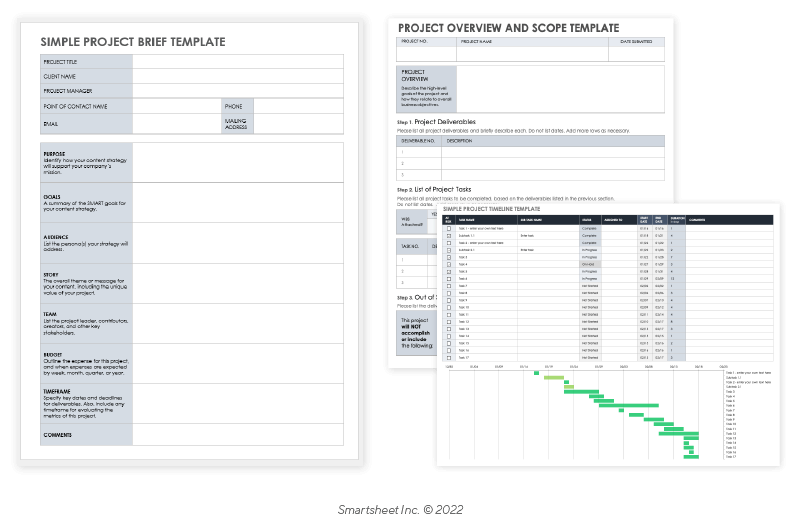
Download Project Brief Starter Kit
We’ve assembled this starter kit to help you write a short but thorough project brief. We’ve collected everything you need to create the most important elements of a brief. These templates are completely customizable to suit any business use case. Download each template individually or as a complete set.
Included in this kit, you’ll find:
- A project overview and scope template for Microsoft Word to help identify your project’s goals, major tasks, and scope.
- A project timeline template for Microsoft Excel to map out and plan your project tasks, phases, and due dates for deliverables.
- A blank copy of the project brief template for Microsoft Word to bring all of this information together into a shareable, single-page document.
For more help with project planning and briefs for all types of projects, check out these collections of project planning and project brief templates .
Best Practices for Writing a Good Project Brief
Writing a good project brief begins with knowing all of your project information. Keep your brief concise, use clear language, and provide all the information your audience needs to understand your project. Include links to more detailed documents.
We’ve outlined some best practices for writing a good project brief below:
- Finalize Project Details First: Your project brief includes information about how and why a project operates and should be completed only after your project details are finalized.
- Be Concise: A project brief should be no more than one page long. You can make documents with additional details available upon request.
- Keep it High Level: Your brief is a summary of the highest-level elements of your project. It should cover surface information without going into unnecessary details.
- Provide Context: A casual reader should be able to understand your project brief. If an element needs context, spend a sentence or two explaining it.
- Use Clear Formatting: Use a template, or format your document to make for easy reading. Each section should be clearly marked, and information should be easy to find on the page.
- Know Your Audience: A project brief may change based on its intended audience. A brief for marketing purposes would probably highlight the successes and innovations of a project, whereas a brief for internal stakeholders might prioritize scheduling and budget information.
- Make Updates When Information Changes: Your brief should always accurately reflect the project. If project details change, be sure your brief reflects those changes.
- Link to More Detailed Information: If your brief is digital, include links to more detailed project information. This way, your readers can access more information without disrupting your work.
Project Brief vs. Creative Brief
A project brief outlines the high-level details of a project, while a creative brief provides requirement details to a creative team. Creative briefs often include input from a client, whereas a project brief is a summary of a project plan.
Customers usually help make a creative brief, which the team or creative agency then approves. With a project brief, however, the project manager will create the document and send it to the client in order to give them a sense of how the team will accomplish the project goals.
Project Brief vs. Executive Summary
A project brief is a summary for a general audience, while an executive summary focuses on details important to stakeholders at the executive level. This document includes such details as budget information, resource use, and project benefits.
A project brief and an executive summary are similar. The major difference is the intended audience. If you are working on a large-scale project or one that is of particular interest to one or more executives, create an executive summary. However, a general project brief might be more appropriate when the project is smaller in scope and is not an executive pet project.
Project Brief vs. Project Plan
A project brief is a concise, high-level summary of your project plan that teams share with stakeholders. A brief only includes essential project information. A project plan, however, includes detailed information about all project elements.
A project plan is a multipage document that outlines and defines a project in its entirety. It includes detailed information on budgets, resources needed, schedules for deadlines and deliverables, task assignments, and more. A project brief outlines the most important, high-level information from a project plan and packages it in a scannable format.
Project Brief vs. Business Case
A business case outlines the reasons for taking on a project and how it will benefit the business. A project brief might include these details, in addition to information about the project’s timeline, goals, and scope.
A business case is useful for presenting project information to executives who care primarily about its impact on the business as a whole. A brief is more useful to stakeholders who might interact with the project on a more familiar basis.
Project Brief vs. Project Charter
A project charter contains detailed project information that has not yet been approved or developed into a full project plan. A project brief summarizes the overview, scope, and timeline information found in the finalized project plan.
A project charter should outline a project for formal review by a project’s sponsor during the initiation phase of project planning. It includes project information that hasn’t yet been hammered out. A project brief should include only objectively true, finalized information about how a project will proceed.
Project Brief vs. Project Roadmap
A project roadmap focuses on a project’s key deliverables and timeline. A project brief includes timeline information and an overview of the project’s strategy and goals.
A project roadmap is a useful tool to visualize a project’s deadlines and deliverables.
To learn more, check out this guide to creating and using project roadmaps in project management.
Get the Most Out of Your Project Briefs with Smartsheet
Empower your people to go above and beyond with a flexible platform designed to match the needs of your team — and adapt as those needs change.
The Smartsheet platform makes it easy to plan, capture, manage, and report on work from anywhere, helping your team be more effective and get more done. Report on key metrics and get real-time visibility into work as it happens with roll-up reports, dashboards, and automated workflows built to keep your team connected and informed.
When teams have clarity into the work getting done, there’s no telling how much more they can accomplish in the same amount of time. Try Smartsheet for free, today.
Discover why over 90% of Fortune 100 companies trust Smartsheet to get work done.
Filter by Keywords
10 Free Project Brief Templates: Word, Google Docs, and ClickUp
Praburam Srinivasan
Growth Marketing Manager
February 13, 2024
Start using ClickUp today
- Manage all your work in one place
- Collaborate with your team
- Use ClickUp for FREE—forever
Projects and tasks don’t get completed on their own. Once a task is assigned, there’s a lot of thought and work put into each task to make sure that it will be delivered with the goal and objective set.
Communication is essential to helping your team members understand how they can complete a task best and achieve a successful project. Without clear and precise details and information, they are left with a vague understanding of what exactly is needed from them.
If you’re unsure of the best way to communicate tasks and project assignments, you can use hundreds of free project brief templates available from websites and project management apps like ClickUp.
Each project brief template is designed with a specific purpose so it is best to find the best option for your project management needs.
Let’s go over some of the best project brief templates that you can choose from and how each can help you
What is a Project Brief Template?
What makes a good project brief template, 1. clickup marketing project brief template, 2. clickup product brief document template, 3. clickup project design brief template, 4. clickup event project brief template, 5. clickup marketing campaign brief template, 6. clickup campaign project brief template, 7. clickup creative project brief template, 8. clickup seo content brief template, 9. microsoft word project brief template, 10. google docs project brief template.
A project brief template is a guide or document that outlines the process and objectives of each task or project.
This document often offers a summary of your project plan . It defines what is needed to be completed and provides information such as deadlines and objectives.
A project brief gives team members a full understanding of what is required. Depending on the type of project, each template may vary and include different types of information and details.
Regardless of your business and organization’s industry, everyone can use a project brief template to improve their overall work process.
A good project brief should be short and direct to the point. It should provide a summary, the scope of the project , as well as all the information needed by stakeholders and team members to carry out the project.
A project brief will help:
- improve communication between team members
- minimize setbacks and errors
- encourage collaboration
- align all stakeholders with the same strategy and goals
The project brief document must be able to define project objectives and goals , the expected outcome, and details on how everything should be implemented. This may include the strategy, approach, and plan of action.
The project brief template should also include the key deliverables, especially for big long-term projects.
If applicable, a good project brief should include an estimation of the budget and timeline, which will show the start and finish dates of the project.
Overall, a complete project brief should be able to house all information from summary up to the metrics you need to measure to define project success.
10 Project Brief Templates
There are a variety of free templates to help you create a project brief. Some templates can be easily accessed through MS Word and Google Docs. Each project brief example is free-to-download and can be edited easily anytime.
There are others also offered by productivity platforms and project management solutions like ClickUp. Each free project brief template caters to a different purpose and use. Check them out below!

Marketing projects require a lot of planning and often involve various departments and project stakeholders. This is why keeping tasks organized and teams aligned can be challenging.
This Marketing Project Brief Template by ClickUp will help you get started with a new marketing project. Use this template to organize different project elements and easily implement your project.
Use the template’s custom fields to identify and define each project’s deliverables. You can also add information like department, target audience, and even file attachments to provide more context for each campaign. It is a simple and beginner-friendly template to define a new project to get you started right away.
Main elements of this template:
- Organize your project brief overview into different sections
- Attach important files that are relevant to your project
- List down deliverables needed to complete your project

The Product Brief Document Template by ClickUp is a complete document to help you and your development team work towards achieving a successful product launch. Provide your team with complete information, draft histories, tasks, business objectives, and other details through this ready-to-use template.
Using this template is the key to organizing the crucial elements of your product development in one document that everyone can refer to when in need of additional information. This detailed yet flexible project brief document can be everyone’s reference during the product development and delivery process.
Add this template to your Workspace and get access to eight pages dedicated to defining each stage of the project. It is an easy fill-in-the-blank document that you can customize according to your preference and product requirements.
- Collaborate cross-functionality between teams on product development
- Organize product specs, feedback, and related tasks in the same place
- Outline objectives, solutions, and specs in the project brief

If you’re a design team leader, project manager, or designer yourself, you’ll know how the design process can get complicated or lengthy. This is especially true when stakeholders and other parties are involved from the planning to the approval stage.
Providing a design brief is one way to minimize setbacks and keep everyone on the same page with how the process should be carried out. The Design Brief Whiteboard Template by ClickUp is made specifically for design project brief, which usually involves a lot of elements and key people.
Add this template and outline your design brief with statuses and a view to conducting an initial briefing for a design. Customize this project brief template to note client requests, define brand highlights, set objectives, and even add the names of the key people involved. Everyone can stay aligned by referring to just one document to help the project and the actual design output on track.
- Organize details and information about a design project in a whiteboard-style canvas
- Color-coded sections for better organization of information
- Customize design brief template according to your preference and needs

This ClickUp project brief template provides you with a simple project outline to organize your event’s key elements and goals. Plan a successful event and identify challenges with this Event Project Brief Template by ClickUp document.
By creating a project brief for your event, you are able to align all stakeholders with your goals and kickstart your planning with a specific objective in mind. The project brief template comes with three pages which include an event brief, a project summary, and the event schedule.
- Project brief template includes an outline of goals and key elements to planning a successful event
- Pages are divided into the event brief, summary, and schedule of the event for better organization
Check out these AI outline generators !

Successfully implement and run a marketing campaign starting with a complete campaign brief with this Marketing Campaign Brief Template by ClickUp . Define your marketing goals and other important details with this ClickUp Marketing Campaign Brief template.
Include this project brief template in your Workspace to assist you with managing your marketing campaign from start to finish. This simple yet flexible template can be customized to include all elements that will be crucial to running a successful marketing campaign.
- Flexible project brief to manage marketing campaign from start to finish
- Marketing campaign brief includes an outline of marketing goals, client details, target market, and more

If you’re looking for a more general template for bigger marketing campaigns that involve more people and departments, this Campaign Project Brief Template by ClickUp will help you gain alignment across all stakeholders.
This is another simple and flexible template but with additional pages and sections for each element of the campaign, including Campaign Brief Examples, Campaign Brief, Video Campaign Brief, and SEO Content Brief.
- Project brief includes five pages to define the entire scope of the marketing campaign
- Dedicated section for creative, video, and SEO
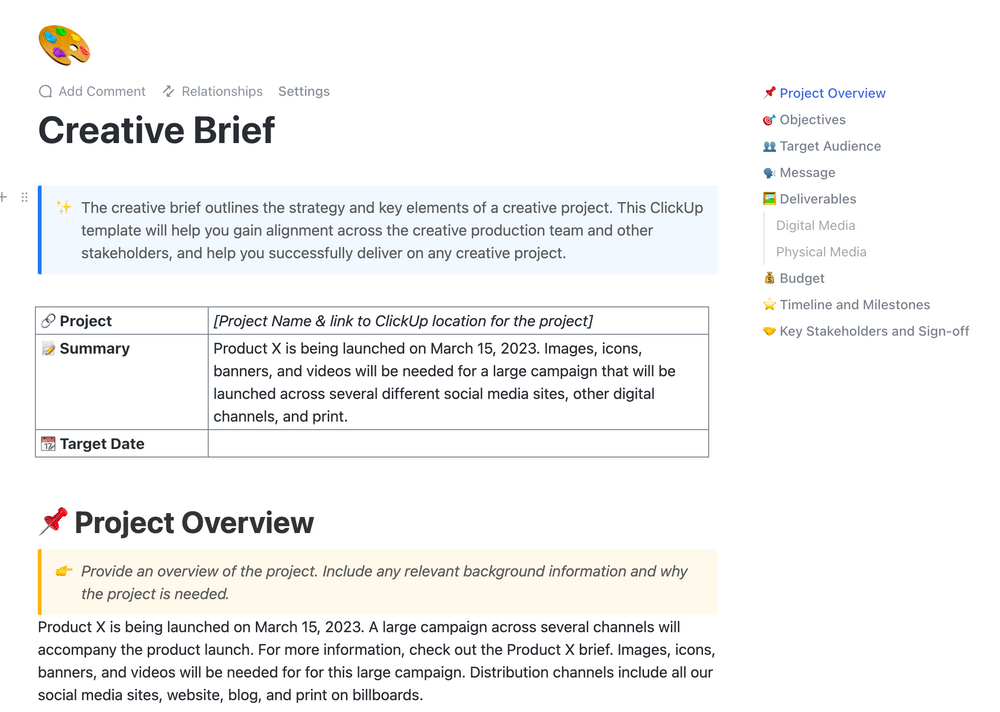
Providing a project brief for a creative project will lay the foundation to get everyone from account managers to designers and content creators on the same page. While everyone will be a part of the process, not every single member of the team will be involved in important aspects such as client meetings or calls.
A creative project brief is an easy way to summarize key information relevant to completing the project. Gain alignment across the creative team with this Creative Brief Document Template by ClickUp . Use this template to outline your creative project’s strategy and key elements.
- Outline your strategy and key elements in one simple and flexible template
- One creative brief page includes tables and sections to organize various elements of a creative project

Aside from content calendars , Content briefs help content writers come up with high-quality content that is optimized for search engines while being able to deliver a specific intended message. Providing content writers with a content project brief will help them understand the structure and intent of the content that is needed from them.
Help your writers stay aligned with your strategy by using this SEO Content Brief Template by ClickUp . This template provides information such as the target audience, messaging keywords, outline, topics, links, and more.
Get access to this document template by adding it to your ClickUp workspace. It is a simple fill-in-the-blank document that you or a project manager can customize according to the content’s scope and requirements.
- Compile key elements like keywords and messaging into one document to help writers create optimized content for search engines
- Fill in the blank project brief template for information such as title tags, meta description, word count, objective, and more

If you’re looking for a simple project brief template for MS Word, check out this ready-to-use template. This document includes a detailed page to include a project’s goals, timeline, description, costs, and stakeholders, among other information.
A project manager can customize this project brief document and include additional information and details that you think you will need to reach the finish line. In your MS Word document , you can also add new pages to provide more context and better organize different types of information in your project brief.
- Editable project brief template for MS Word use
- Fill in the blanks to create a quick and detailed project brief
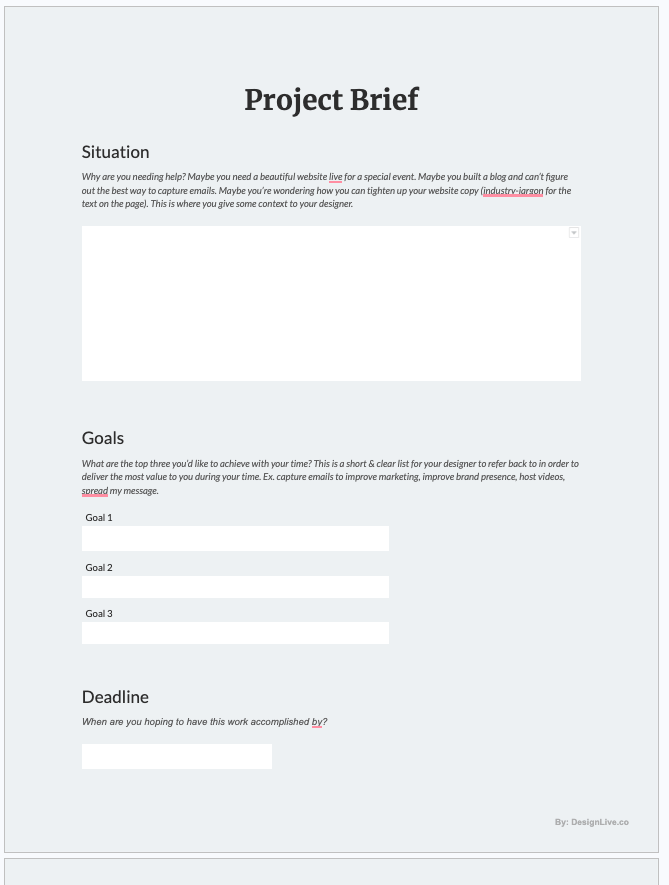
Small teams and organizations looking for an easy way to create a project brief can use this Google Docs Project Brief Template. Ensure that your project stays on track and achieves your goals while meeting the demands of your clients or target audience by using this project brief template as a guide.
This template has a simple and clean outline that you or a project manager can customize to include additional information. It currently has fields to define your project’s purpose, goals, audience, team, and budget.
- Easy to use template to create a project brief using Google Docs or MS Word
- Includes fields for general project information such as goals, audience, team, budget, and more
Streamline Project Planning with Ready-to-Use Templates
Creating project brief documents is an important aspect of any project. However, it should be easy and straightforward. It must be able to improve your overall project process, not prolong it. Find the best template for your project and use it to achieve project milestones and goals.
Project brief templates can be customized according to your needs and preferences. These templates are free and ready for your use. All you have to do is find the best one for your project. On top of these templates, ClickUp has a library of more than 1000 templates that you can access with an account for free!
Aside from templates, ClickUp is packed with features and functional tools that you can use to provide your team or a project manager with complete information about your tasks.
ClickUp is a true productivity platform for any type of team and project size. Start using ClickUp for free today!

Questions? Comments? Visit our Help Center for support.
Receive the latest WriteClick Newsletter updates.
Thanks for subscribing to our blog!
Please enter a valid email
- Free training & 24-hour support
- Serious about security & privacy
- 99.99% uptime the last 12 months
- Contact sales
Start free trial
Get your free
Project Brief Template
Use this free Project Brief Template for Word to manage your projects better.
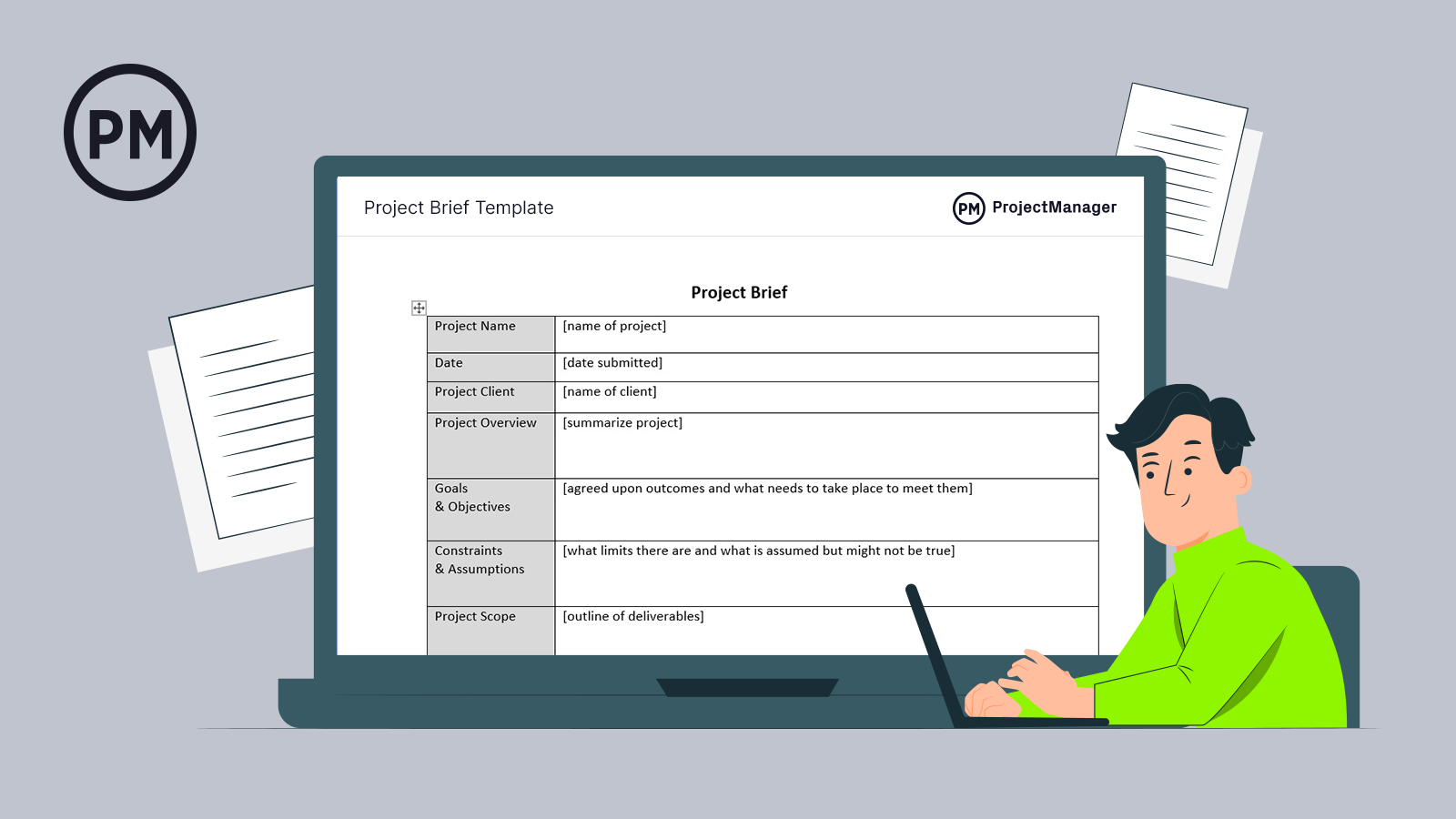
Whether you’re starting to work on a project plan or need to explain the project in broad terms to your stakeholders, you need a project brief to define all the main points. It’s the best way to inform and communicate the project summary.
Get a head start on your project brief by downloading our free project brief template—all you’ll need to do is fill in the details.
What Is a Project Brief Template?
A project brief outlines the approach and process of a project. It summarizes the main parts of a project, including whatever requirements there are. As the name implies, the document is meant to be brief! This is not the place to dive deep into the finer details.
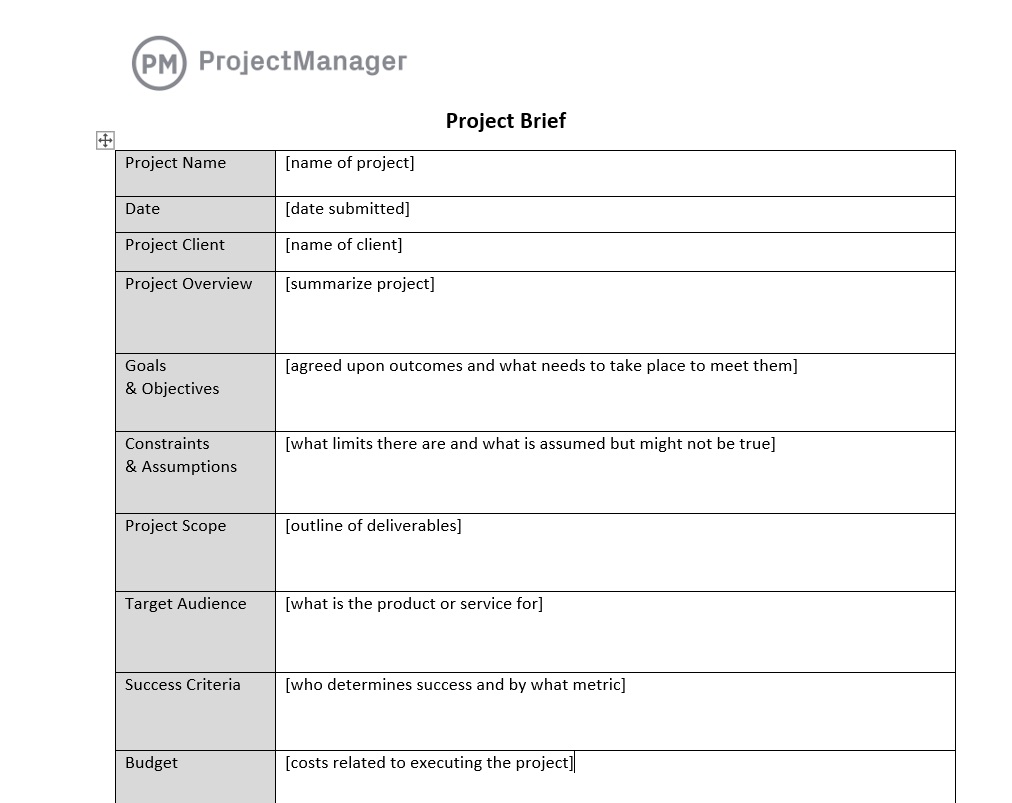
Instead, the project brief is where the major kinks are worked out. Here, you’ll determine the objectives, goals, scope, major deliverables, milestones, process and resources. By laying this out, you ensure that everyone is on the same page for the more complex project plan.
The project brief can be seen as a summary of your project plan. It will talk about roughly the same elements, only in an abbreviated form. For example, the project plan will go into the budget, the communication plan and much more. The project brief tends to focus solely on the objective, schedule and scope, although it can include the target audience as well.
Why Do You Need a Project Brief Template?
Use a project brief to capture the main elements of your project and communicate them to the project team and stakeholders. Through clear communication, your project will run smoothly.
The project brief also lays the groundwork for the larger project plan. By getting the broad strokes down and defining the project from a high-level view, planning is easier because you have a clear sense of the direction it needs to take.
Using our project brief template helps you make sure you don’t overlook any important details as you define the end goal of the project. This template will sketch out details such as the client, project objectives and details. All of which is key to managing a successful project.
The project brief template sketches the broad strokes, but to get the full picture and better communicate the plan to your team and stakeholders, project management software is required. ProjectManager builds your project scope into a schedule. Our Gantt chart does more than populate a project timeline, it automatically calculates your critical path and then saves the plan to use as a ruler to measure your actual progress during execution. Create your budget by adding planned resource costs, which can also be compared to actual costs once the project begins. Our tool turns your proposal into a successful project.
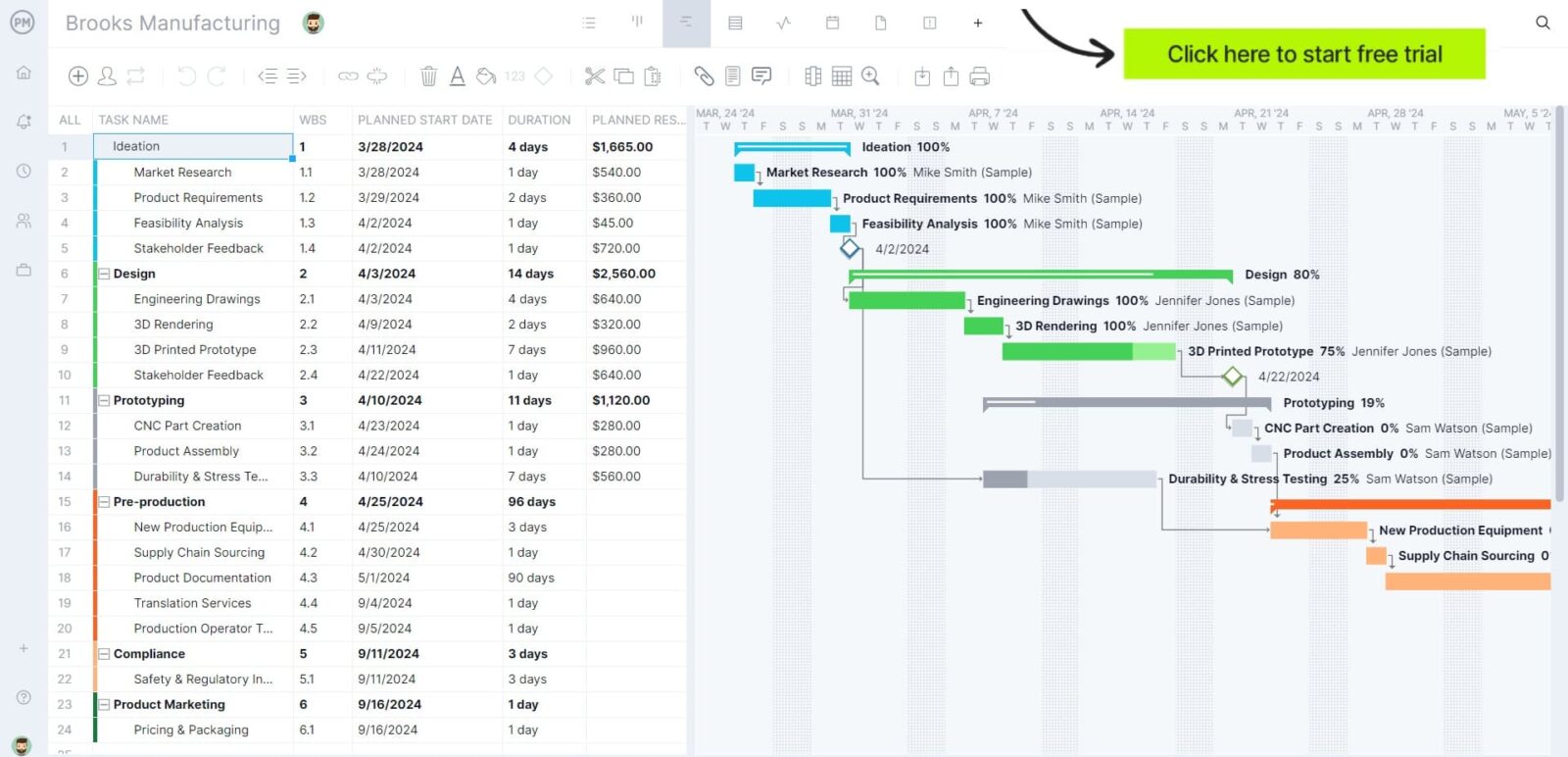
Who Uses a Project Brief Template?
The project brief is used by the project manager to inform the project stakeholder and the project team about the main goal of the project. It is prepared by the project manager and then reviewed by those who use it, including suppliers.
The final project brief is approved by the organization’s executives. It’s all part of the initiation phase of a project but is often referred to throughout the life cycle of the project. In a sense, it’s used by everyone in the project as a compass to make sure they’re all heading in the right direction.
How to Use Our Free Project Brief Template
Just follow these steps and you’ll have this project brief template ready to share with stakeholders and your team in no time.
Project Name and Date
The project name and date that the brief was made are located on the top right-hand side of the document. This identifies what it is and attaches it to one project, which is helpful when your organization is managing a program or portfolio. It also makes it easier to find after the project is completed; you may want to use the brief as historical data for a new, similar project.
Summary, Goals and Objectives
After that comes the meat of the project brief. It begins with the client for the project and then a summary of the project. Then, you input the goals and objectives of the project; in other words, the agreed upon outcomes and how you’re going to get there.
Constraints and Assumptions
Next, there’s a space to outline the constraints and assumptions of the project. These are the things that might limit your progress and other things you’re taking for granted that might end up surprising you. This is followed by the scope of the project , which outlines deliverables.
Target Audience and Responsible Parties
Whether you’re making a product or service, there’s a target audience and they must be defined in the project brief. Here, you can outline who they are and how the project meets a need they have. The next space is where you identify who is responsible for determining that the project is successful and by what criteria they will measure that success.
Budget and Timeline
While not a fully realized budget, there is a place for you to outline the costs associated with executing the project. There is also a timeline or schedule of events that will make up the project. This will show the duration of the project by making an accurate estimation of the time it will take between the start and the finish of the project.
How ProjectManager Turns Your Brief Into a Project
ProjectManager is an award-winning project management software that organizes tasks, teams and projects. Once stakeholders approve your brief and the team understands it, you have to execute it. Our online software helps you better plan, monitor and report on your project.
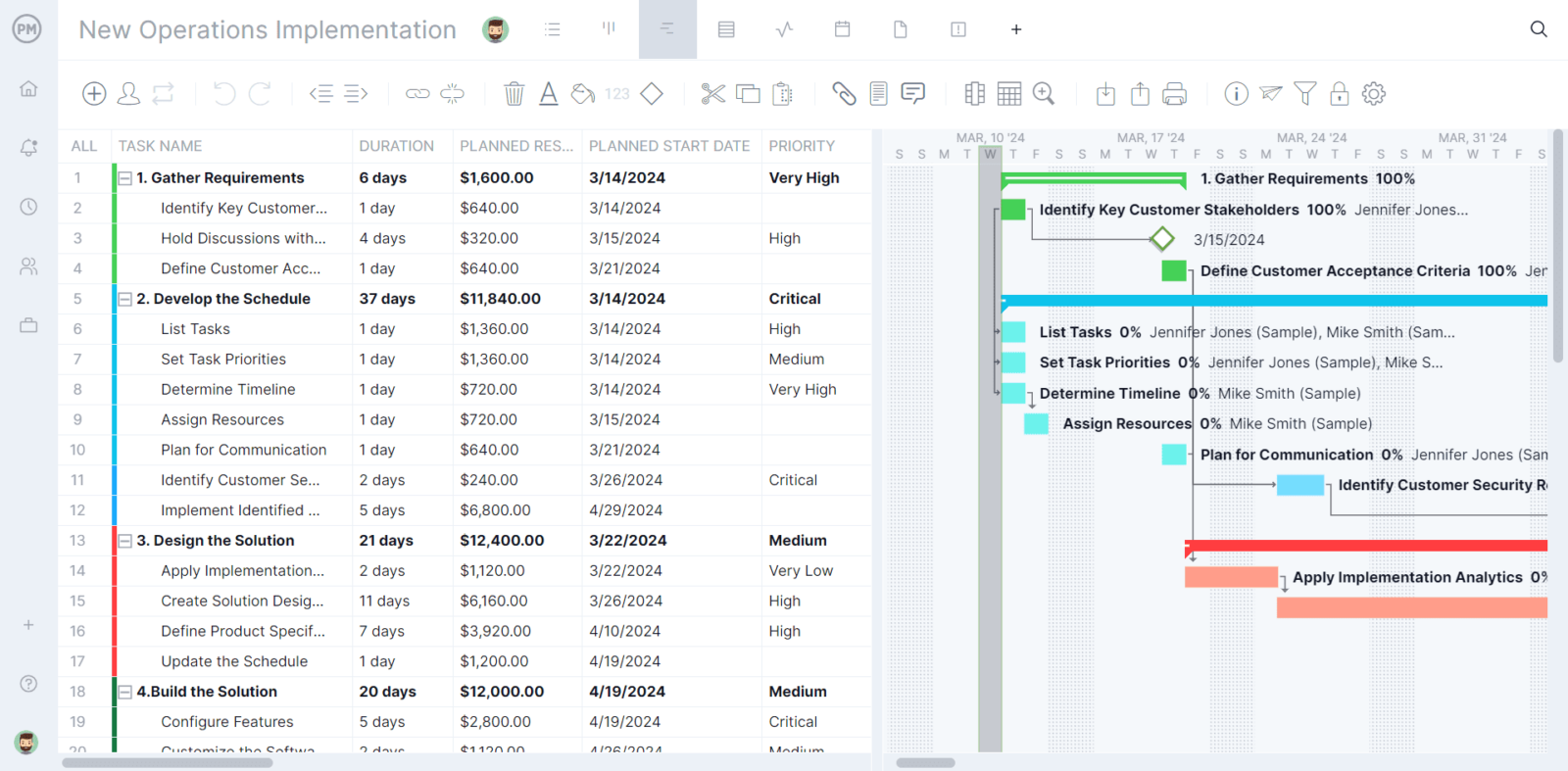
Once you have broken your final deliverable into tasks that get you there, manage them on the Gantt chart. The Gantt schedules your work, lets you link dependent tasks to avoid bottlenecks and breaks down the project into phases.
High-level views of the project’s performance and progress are available on the real-time dashboard, which does all the calculations for you and displays cost, project variant, workload and more in easy to read graphs and charts. One-click filterable reports keep stakeholders updated.
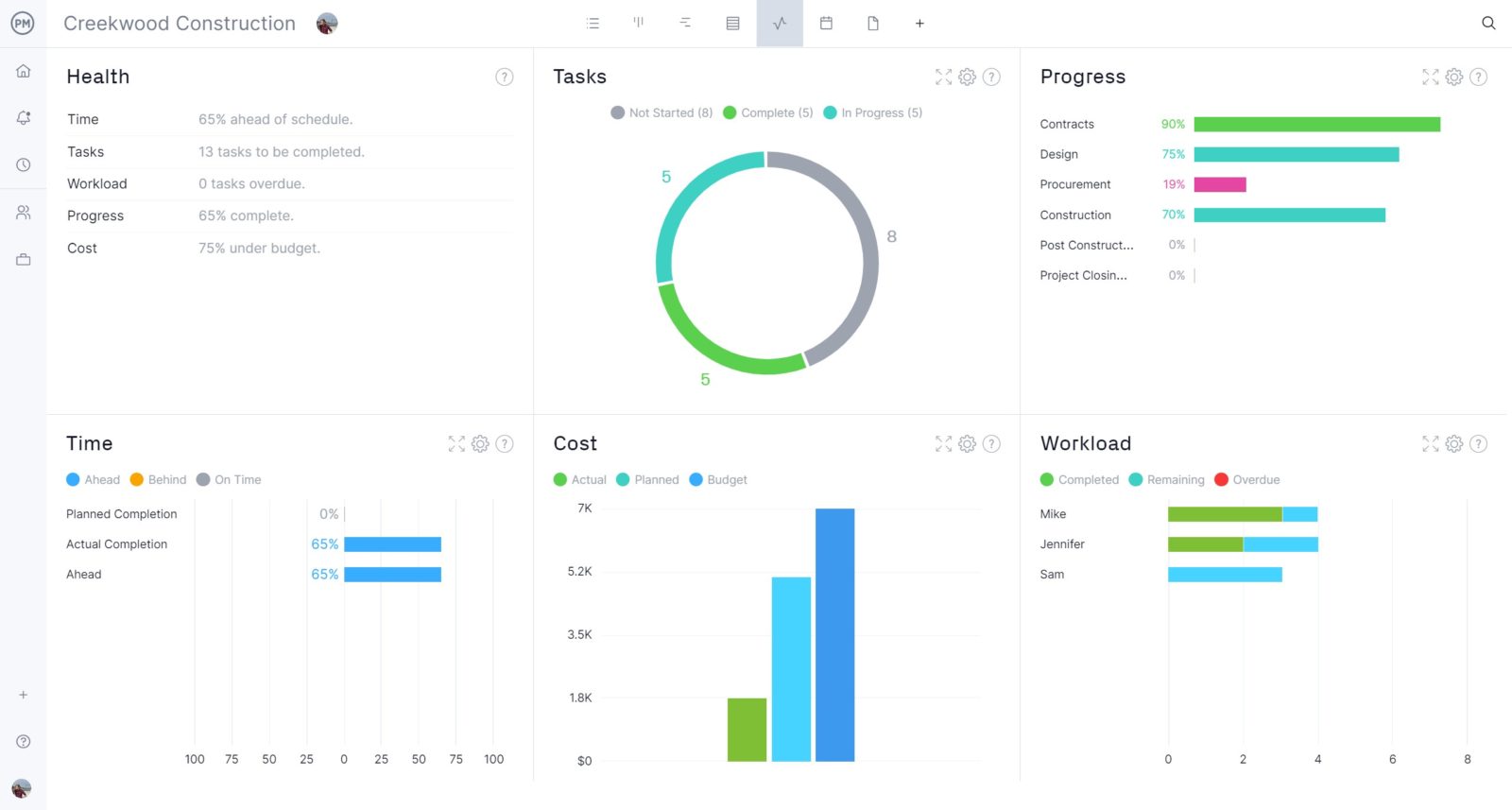
Other Templates to Help With Your Project Brief
ProjectManager has dozens of free project management templates that assist you over the life cycle of your project. Here are a few that can help you get your project brief together.
Project Budget Template
While your project brief will not go into detail about the budget, costs are important to outline. To get a jump on the financial component of your project, use our free project budget template. It outlines the cost of your project and helps you monitor your expenditure.
Project Charter Template
Because you need to define the goals of the project when composing a brief, it can be very helpful to use our free project charter template. The project charter defines the vision of the project, it’s objective, scope and deliverables—all relevant to your project brief.
Statement of Work Template
The free statement of work template is another means to collect all the pertinent information about your project and, in turn, help you develop the project brief. It speaks to the activities, deliverables and timetable to get all this work done.
Related Content
ProjectManager is also an online hub that publishes hundreds of blogs, tutorial videos and guidebooks on every aspect of project management. It’s a great resource for newcomers and seasoned professionals. Here are just a few of the pieces on the site that are relevant to creating a project brief.
- Project Documentation: 15 Essential Project Documents
- Project Development: Everything You Need to Get Started
- Premortem on Projects: How to Do It & Why
- Cost Estimation for Projects: How to Estimate Accurately
ProjectManager is a cloud-based tool that helps you plan, schedule, execute, monitor and report on your project to keep it on track and within budget. Our software gives you the features you need to turn your project brief into a successful project. Join the tens of thousands of teams who are already managing their projects with ProjectManager and take this free 30-day trial today.
Start your free 30-day trial
Deliver faster, collaborate better, innovate more effectively — without the high prices and months-long implementation and extensive training required by other products.
WTO / Business / Reports / 12 Free Project Brief Templates & Examples (Word | PDF)
12 Free Project Brief Templates & Examples (Word | PDF)
At some point, you might wonder why a given project doesn’t turn out the way you expected it to be. Usually, this is a common problem experienced by inexperienced marketers and designers. Well, if you have experienced such, it’s probably because you didn’t define the project objectives, expectations, and deliverables earlier on stage. Therefore, to avoid such scenarios, you must implement a detailed project brief template before commencing the actual project.
In simple terms,
A project brief is a document that highlights all the project ideas. It contains the essential requirements of the project, including the goals, scope, and constraints.
Also, it describes what is required and the time frame needed for the project to achieve its goals. If handled with the utmost care and significant consideration, a good template for a project brief should be able to address various parameters such as who, why, what, and when of your projects.
Free Templates
Word format.
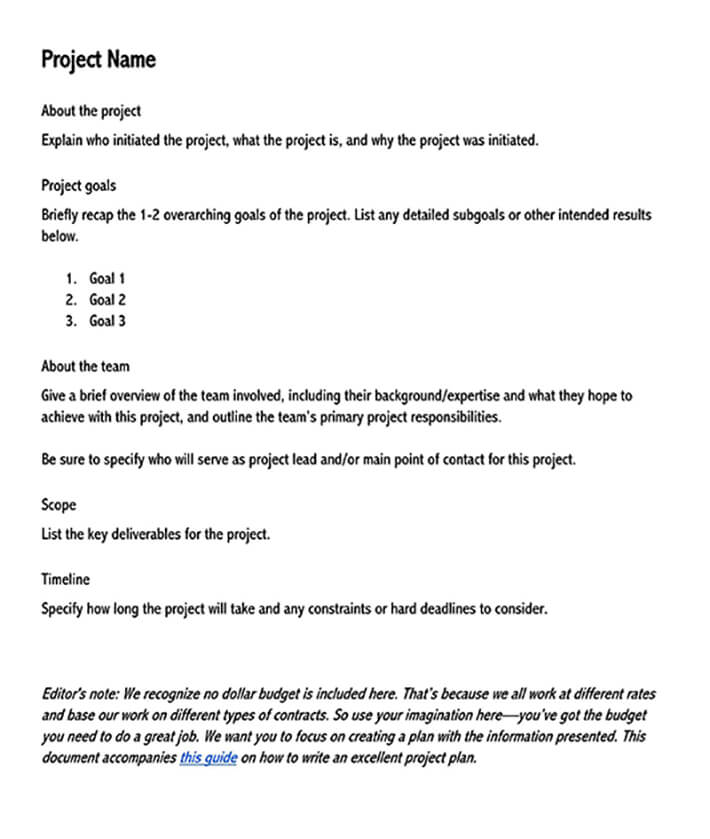
How Important is a Project Brief to Your Project?
If you have ever planned a road trip, you’ll understand the importance of having a map. Just like the way a map guides you towards your destination, a project brief similarly guides your project towards its successful completion.
Therefore, writing this ensures your project goes as required. It helps make informed decisions, proper management, and scope execution. Therefore, before proceeding with your project, always think of the following benefits:
Contributes to the effective project outcome
A project brief makes you in a better position to understand the logistics needed in your project. This makes you know which supplies are best for your project. Also, you’ll always know what problems can occur and how to address them best.
Lastly, you’ll always guide the implementation of the project towards the defined goals and objectives. Eventually, the project will have a successful and productive outcome.
Saves time and money
As mentioned earlier, the project brief template makes you understand what it takes to make your project successful. With such a knowledge background, you’ll always give a precise estimate of supplies. Therefore, your suppliers will always get it right from the word go. As a result, cases of project delays and inflated costs will be reduced significantly.
Makes management of costs easier
Once you’ve identified what you want for your project, you’ll always work harmoniously with your project suppliers. At the same time, your supplier/project implementer won’t have to spend much on researching your business, your competitors, and your target audience. Working on an agreed project brief, therefore, the template makes the project management more comfortable and more efficient.
Step by Step Guide to Write a Project Brief
The length of your project brief template can vary with the type, scope, or scale of your project. The more elaborate your plan is, the longer the project brief will be. However, you should always ensure your brief flows naturally as per your project requirements.
If you are wondering where to start with your project brief, here is a step-by-step guide that will help you through:
Identify your company profile
Before going into any detail, you should be able to explain who the project is being created for and for what purpose. Once you’ve identified your intended clients, you’ll make it easy for your project managers to understand the client and the brand more easily. Also, be sure to mention what your projects focus on and the main features being delivered.
Describe what your project is all about
Here, you need to provide an overview of what your project entails. Mention whether your project is creating new products/services or redesigning things that already existed. Also, mention which stakeholder will be responsible for the project implementation. Lastly, identify some critical details as well as the requirements needed in the project implementation in the template. Remember, meeting the requirements of the project plays a crucial role in the overall completion of any given project.
Define your objectives
Usually, setting well-defined objectives can be easier said than done. However, if you want to set better goals, always use the SMART principle, i.e., your goals should be Specific (mention the 5Ws, i.e., who, why, when, what, and where), Measurable (include some figures or metrics), Achievable, Realistic and Timely.
Identify your target audience
To achieve your project goals, you need to create a personalised project. Ensure your project creates things that meet the demands of your target audience. Therefore, take some time and learn your target audience. Ask them about their likes and preferences. This will provide you with an essential insight on how to meet their needs.
Plan your schedules and budget
Once you’ve identified your audience, you must work on your time frame as well. Every project implementation requires proper budgeting and scheduling. Prior budgeting and scheduling help avoid the last-minute rush, which would otherwise affect the overall project outcome. Therefore, note down what is expected and at what date in the project brief template. Also, calculate the total project budget that will be needed to complete the project successfully.
Determine the project scope
For your project to achieve its ambition, it needs a well-defined scope. Range helps outline the project’s deliverables, features, tasks, budget, and deadlines. Also, it helps you to stay relevant in your project execution. Defining your project scopes is an essential step for internal planning and helps in reaching a clear understanding among different stakeholders.
Measure your success
This is the final step of making your project brief here; you need to evaluate whether the effort, resources, and time put into the project will pay off. If not, you will determine what needs to be done to make the project successful.
What to Include in a Project Brief Template?
- Background overview
- Project objectives, ambition, and goals
- Challenges likely to be faced
- Target audience
- Description of competition
- Time schedules
- Contact information
The success of a project, regardless of its size, majorly depends on prior planning. Proper planning helps in proper project execution as it enlightens every stakeholder of what is required at a specific time. One thing that makes project planning effective is a project brief. A project brief helps outline all the milestones, and everything needed to complete a project successfully. Therefore, if you are planning to do a project, don’t forget to draft a project brief.
About This Article

Was this helpful?
Great! Tell us more about your experience
Not up to par help us fix it, keep reading.

Business , Reports

Business , Statements
20 best creative brief templates & examples.

How to Write Marketing Brief (12 Perfect Examples)

Analysis , Education
40 free venn diagram templates [2, 3, and 4-circle].

Debt , Letters and Emails
Payment reminder emails for overdue invoices – templates.

Free Editable Franchise Agreement Templates

Business , Receipts
Free fillable blank check templates (how to fill) – word, pdf, thank you for your feedback.
Your Voice, Our Progress. Your feedback matters a lot to us.

How to Write a Research Proposal: (with Examples & Templates)

Table of Contents
Before conducting a study, a research proposal should be created that outlines researchers’ plans and methodology and is submitted to the concerned evaluating organization or person. Creating a research proposal is an important step to ensure that researchers are on track and are moving forward as intended. A research proposal can be defined as a detailed plan or blueprint for the proposed research that you intend to undertake. It provides readers with a snapshot of your project by describing what you will investigate, why it is needed, and how you will conduct the research.
Your research proposal should aim to explain to the readers why your research is relevant and original, that you understand the context and current scenario in the field, have the appropriate resources to conduct the research, and that the research is feasible given the usual constraints.
This article will describe in detail the purpose and typical structure of a research proposal , along with examples and templates to help you ace this step in your research journey.
What is a Research Proposal ?
A research proposal¹ ,² can be defined as a formal report that describes your proposed research, its objectives, methodology, implications, and other important details. Research proposals are the framework of your research and are used to obtain approvals or grants to conduct the study from various committees or organizations. Consequently, research proposals should convince readers of your study’s credibility, accuracy, achievability, practicality, and reproducibility.
With research proposals , researchers usually aim to persuade the readers, funding agencies, educational institutions, and supervisors to approve the proposal. To achieve this, the report should be well structured with the objectives written in clear, understandable language devoid of jargon. A well-organized research proposal conveys to the readers or evaluators that the writer has thought out the research plan meticulously and has the resources to ensure timely completion.
Purpose of Research Proposals
A research proposal is a sales pitch and therefore should be detailed enough to convince your readers, who could be supervisors, ethics committees, universities, etc., that what you’re proposing has merit and is feasible . Research proposals can help students discuss their dissertation with their faculty or fulfill course requirements and also help researchers obtain funding. A well-structured proposal instills confidence among readers about your ability to conduct and complete the study as proposed.
Research proposals can be written for several reasons:³
- To describe the importance of research in the specific topic
- Address any potential challenges you may encounter
- Showcase knowledge in the field and your ability to conduct a study
- Apply for a role at a research institute
- Convince a research supervisor or university that your research can satisfy the requirements of a degree program
- Highlight the importance of your research to organizations that may sponsor your project
- Identify implications of your project and how it can benefit the audience
What Goes in a Research Proposal?
Research proposals should aim to answer the three basic questions—what, why, and how.
The What question should be answered by describing the specific subject being researched. It should typically include the objectives, the cohort details, and the location or setting.
The Why question should be answered by describing the existing scenario of the subject, listing unanswered questions, identifying gaps in the existing research, and describing how your study can address these gaps, along with the implications and significance.
The How question should be answered by describing the proposed research methodology, data analysis tools expected to be used, and other details to describe your proposed methodology.
Research Proposal Example
Here is a research proposal sample template (with examples) from the University of Rochester Medical Center. 4 The sections in all research proposals are essentially the same although different terminology and other specific sections may be used depending on the subject.

Structure of a Research Proposal
If you want to know how to make a research proposal impactful, include the following components:¹
1. Introduction
This section provides a background of the study, including the research topic, what is already known about it and the gaps, and the significance of the proposed research.
2. Literature review
This section contains descriptions of all the previous relevant studies pertaining to the research topic. Every study cited should be described in a few sentences, starting with the general studies to the more specific ones. This section builds on the understanding gained by readers in the Introduction section and supports it by citing relevant prior literature, indicating to readers that you have thoroughly researched your subject.
3. Objectives
Once the background and gaps in the research topic have been established, authors must now state the aims of the research clearly. Hypotheses should be mentioned here. This section further helps readers understand what your study’s specific goals are.
4. Research design and methodology
Here, authors should clearly describe the methods they intend to use to achieve their proposed objectives. Important components of this section include the population and sample size, data collection and analysis methods and duration, statistical analysis software, measures to avoid bias (randomization, blinding), etc.
5. Ethical considerations
This refers to the protection of participants’ rights, such as the right to privacy, right to confidentiality, etc. Researchers need to obtain informed consent and institutional review approval by the required authorities and mention this clearly for transparency.
6. Budget/funding
Researchers should prepare their budget and include all expected expenditures. An additional allowance for contingencies such as delays should also be factored in.
7. Appendices
This section typically includes information that supports the research proposal and may include informed consent forms, questionnaires, participant information, measurement tools, etc.
8. Citations

Important Tips for Writing a Research Proposal
Writing a research proposal begins much before the actual task of writing. Planning the research proposal structure and content is an important stage, which if done efficiently, can help you seamlessly transition into the writing stage. 3,5
The Planning Stage
- Manage your time efficiently. Plan to have the draft version ready at least two weeks before your deadline and the final version at least two to three days before the deadline.
- What is the primary objective of your research?
- Will your research address any existing gap?
- What is the impact of your proposed research?
- Do people outside your field find your research applicable in other areas?
- If your research is unsuccessful, would there still be other useful research outcomes?
The Writing Stage
- Create an outline with main section headings that are typically used.
- Focus only on writing and getting your points across without worrying about the format of the research proposal , grammar, punctuation, etc. These can be fixed during the subsequent passes. Add details to each section heading you created in the beginning.
- Ensure your sentences are concise and use plain language. A research proposal usually contains about 2,000 to 4,000 words or four to seven pages.
- Don’t use too many technical terms and abbreviations assuming that the readers would know them. Define the abbreviations and technical terms.
- Ensure that the entire content is readable. Avoid using long paragraphs because they affect the continuity in reading. Break them into shorter paragraphs and introduce some white space for readability.
- Focus on only the major research issues and cite sources accordingly. Don’t include generic information or their sources in the literature review.
- Proofread your final document to ensure there are no grammatical errors so readers can enjoy a seamless, uninterrupted read.
- Use academic, scholarly language because it brings formality into a document.
- Ensure that your title is created using the keywords in the document and is neither too long and specific nor too short and general.
- Cite all sources appropriately to avoid plagiarism.
- Make sure that you follow guidelines, if provided. This includes rules as simple as using a specific font or a hyphen or en dash between numerical ranges.
- Ensure that you’ve answered all questions requested by the evaluating authority.
Key Takeaways
Here’s a summary of the main points about research proposals discussed in the previous sections:
- A research proposal is a document that outlines the details of a proposed study and is created by researchers to submit to evaluators who could be research institutions, universities, faculty, etc.
- Research proposals are usually about 2,000-4,000 words long, but this depends on the evaluating authority’s guidelines.
- A good research proposal ensures that you’ve done your background research and assessed the feasibility of the research.
- Research proposals have the following main sections—introduction, literature review, objectives, methodology, ethical considerations, and budget.

Frequently Asked Questions
Q1. How is a research proposal evaluated?
A1. In general, most evaluators, including universities, broadly use the following criteria to evaluate research proposals . 6
- Significance —Does the research address any important subject or issue, which may or may not be specific to the evaluator or university?
- Content and design —Is the proposed methodology appropriate to answer the research question? Are the objectives clear and well aligned with the proposed methodology?
- Sample size and selection —Is the target population or cohort size clearly mentioned? Is the sampling process used to select participants randomized, appropriate, and free of bias?
- Timing —Are the proposed data collection dates mentioned clearly? Is the project feasible given the specified resources and timeline?
- Data management and dissemination —Who will have access to the data? What is the plan for data analysis?
Q2. What is the difference between the Introduction and Literature Review sections in a research proposal ?
A2. The Introduction or Background section in a research proposal sets the context of the study by describing the current scenario of the subject and identifying the gaps and need for the research. A Literature Review, on the other hand, provides references to all prior relevant literature to help corroborate the gaps identified and the research need.
Q3. How long should a research proposal be?
A3. Research proposal lengths vary with the evaluating authority like universities or committees and also the subject. Here’s a table that lists the typical research proposal lengths for a few universities.
| Arts programs | 1,000-1,500 | |
| University of Birmingham | Law School programs | 2,500 |
| PhD | 2,500 | |
| 2,000 | ||
| Research degrees | 2,000-3,500 |
Q4. What are the common mistakes to avoid in a research proposal ?
A4. Here are a few common mistakes that you must avoid while writing a research proposal . 7
- No clear objectives: Objectives should be clear, specific, and measurable for the easy understanding among readers.
- Incomplete or unconvincing background research: Background research usually includes a review of the current scenario of the particular industry and also a review of the previous literature on the subject. This helps readers understand your reasons for undertaking this research because you identified gaps in the existing research.
- Overlooking project feasibility: The project scope and estimates should be realistic considering the resources and time available.
- Neglecting the impact and significance of the study: In a research proposal , readers and evaluators look for the implications or significance of your research and how it contributes to the existing research. This information should always be included.
- Unstructured format of a research proposal : A well-structured document gives confidence to evaluators that you have read the guidelines carefully and are well organized in your approach, consequently affirming that you will be able to undertake the research as mentioned in your proposal.
- Ineffective writing style: The language used should be formal and grammatically correct. If required, editors could be consulted, including AI-based tools such as Paperpal , to refine the research proposal structure and language.
Thus, a research proposal is an essential document that can help you promote your research and secure funds and grants for conducting your research. Consequently, it should be well written in clear language and include all essential details to convince the evaluators of your ability to conduct the research as proposed.
This article has described all the important components of a research proposal and has also provided tips to improve your writing style. We hope all these tips will help you write a well-structured research proposal to ensure receipt of grants or any other purpose.
References
- Sudheesh K, Duggappa DR, Nethra SS. How to write a research proposal? Indian J Anaesth. 2016;60(9):631-634. Accessed July 15, 2024. https://www.ncbi.nlm.nih.gov/pmc/articles/PMC5037942/
- Writing research proposals. Harvard College Office of Undergraduate Research and Fellowships. Harvard University. Accessed July 14, 2024. https://uraf.harvard.edu/apply-opportunities/app-components/essays/research-proposals
- What is a research proposal? Plus how to write one. Indeed website. Accessed July 17, 2024. https://www.indeed.com/career-advice/career-development/research-proposal
- Research proposal template. University of Rochester Medical Center. Accessed July 16, 2024. https://www.urmc.rochester.edu/MediaLibraries/URMCMedia/pediatrics/research/documents/Research-proposal-Template.pdf
- Tips for successful proposal writing. Johns Hopkins University. Accessed July 17, 2024. https://research.jhu.edu/wp-content/uploads/2018/09/Tips-for-Successful-Proposal-Writing.pdf
- Formal review of research proposals. Cornell University. Accessed July 18, 2024. https://irp.dpb.cornell.edu/surveys/survey-assessment-review-group/research-proposals
- 7 Mistakes you must avoid in your research proposal. Aveksana (via LinkedIn). Accessed July 17, 2024. https://www.linkedin.com/pulse/7-mistakes-you-must-avoid-your-research-proposal-aveksana-cmtwf/
Paperpal is a comprehensive AI writing toolkit that helps students and researchers achieve 2x the writing in half the time. It leverages 21+ years of STM experience and insights from millions of research articles to provide in-depth academic writing, language editing, and submission readiness support to help you write better, faster.
Get accurate academic translations, rewriting support, grammar checks, vocabulary suggestions, and generative AI assistance that delivers human precision at machine speed. Try for free or upgrade to Paperpal Prime starting at US$19 a month to access premium features, including consistency, plagiarism, and 30+ submission readiness checks to help you succeed.
Experience the future of academic writing – Sign up to Paperpal and start writing for free!
Related Reads:
How to write a phd research proposal.
- What are the Benefits of Generative AI for Academic Writing?
- How to Avoid Plagiarism When Using Generative AI Tools
- What is Hedging in Academic Writing?
How to Write Your Research Paper in APA Format
The future of academia: how ai tools are changing the way we do research, you may also like, dissertation printing and binding | types & comparison , what is a dissertation preface definition and examples , how to write your research paper in apa..., how to choose a dissertation topic, how to write an academic paragraph (step-by-step guide), maintaining academic integrity with paperpal’s generative ai writing..., research funding basics: what should a grant proposal..., how to write an abstract in research papers..., how to write dissertation acknowledgements.
UX Research Brief Template

Run a successful UX research project
The best products and services are built with an intimate insight into its customers. To achieve this level of insight requires user research, and great user research starts with a clear brief.
This template will help you outline the right user research plan . It covers background information, goals, proposed research methods, target audience and recruitment details, along with any key dates, budget information, and access to past research.
This template is part of the UX/UI Designers collection.
- Set the vision & strategy
- Organize requirements
- Share with your team & clients
- Gather feedback
- Download as PDF or Word
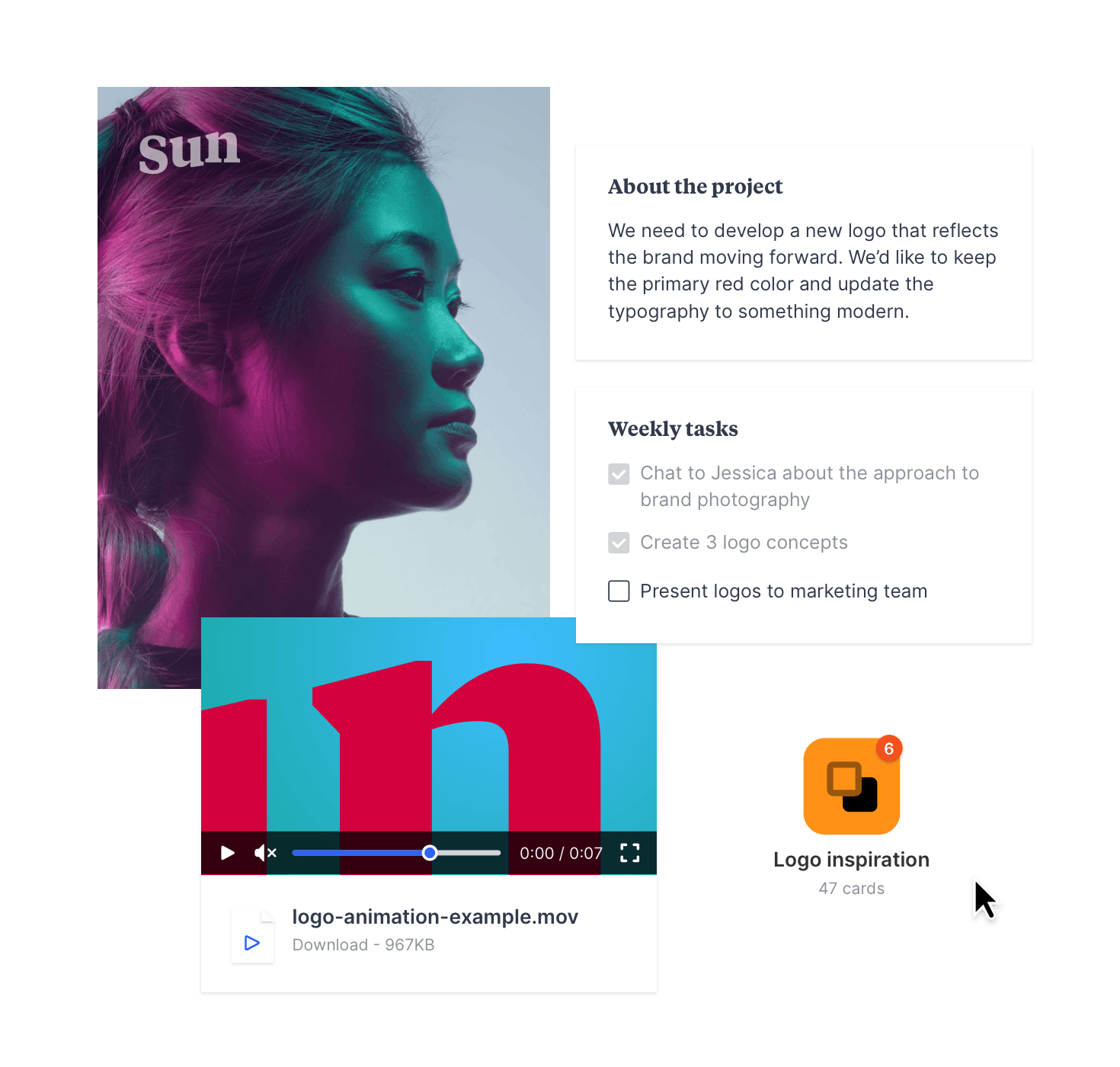
Collect everything in one place
Milanote is the visual way to collect everything that powers your creative work. Simple text editing & task management helps you organize your thoughts and plans. Upload images, video, files and more.
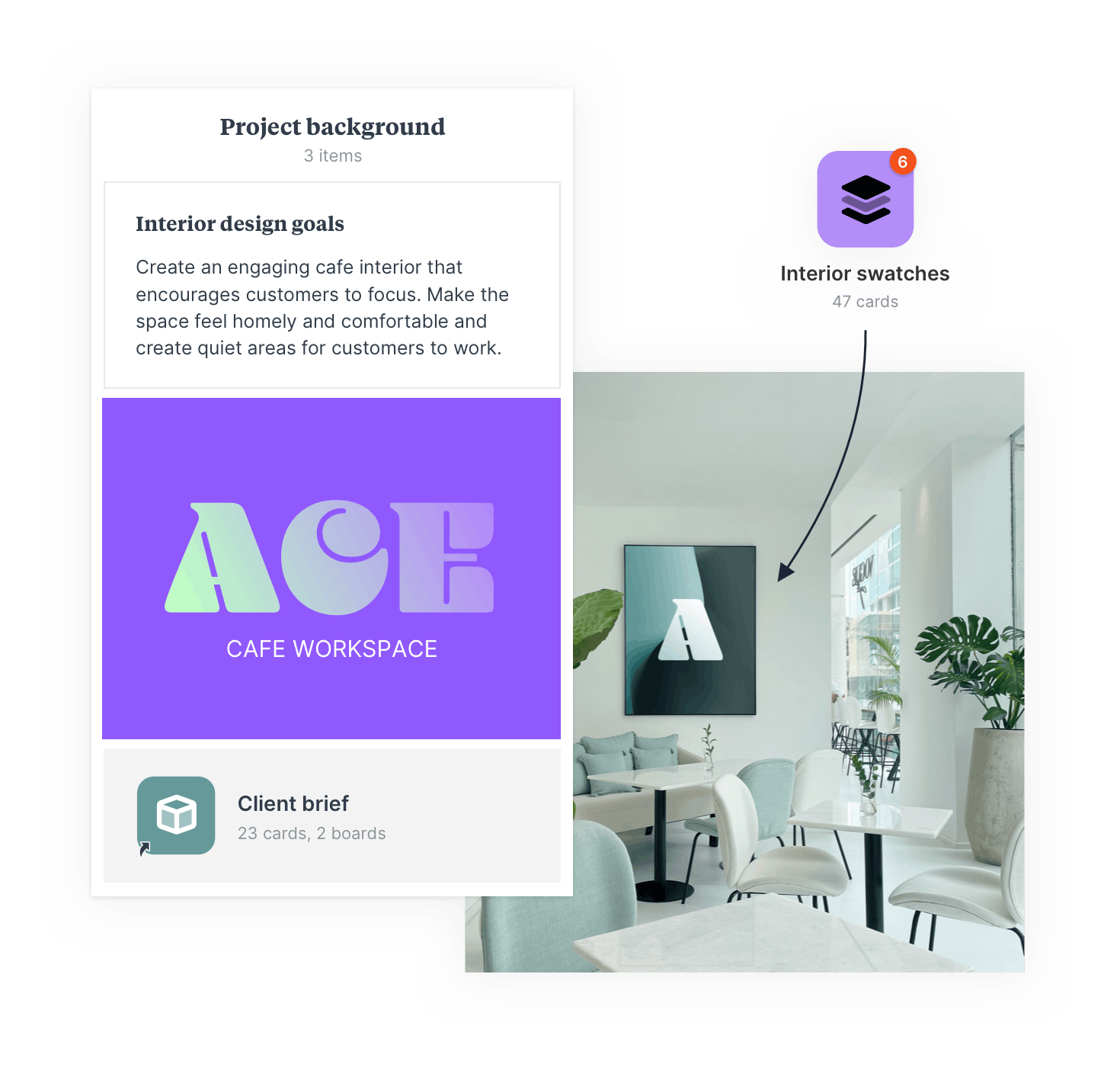
Organize visually
Milanote's flexible drag and drop interface lets you arrange things in whatever way makes sense to you. Break out of linear documents and see your research, ideas and plans side-by-side.

Collaborate with your team
Milanote boards can be a private place to think, or a shared workspace for collaboration—you're in total control of who sees what. Instantly see your team's changes, leave comments, and never miss a thing with smart notifications and alerts.
Plan your website in one place.
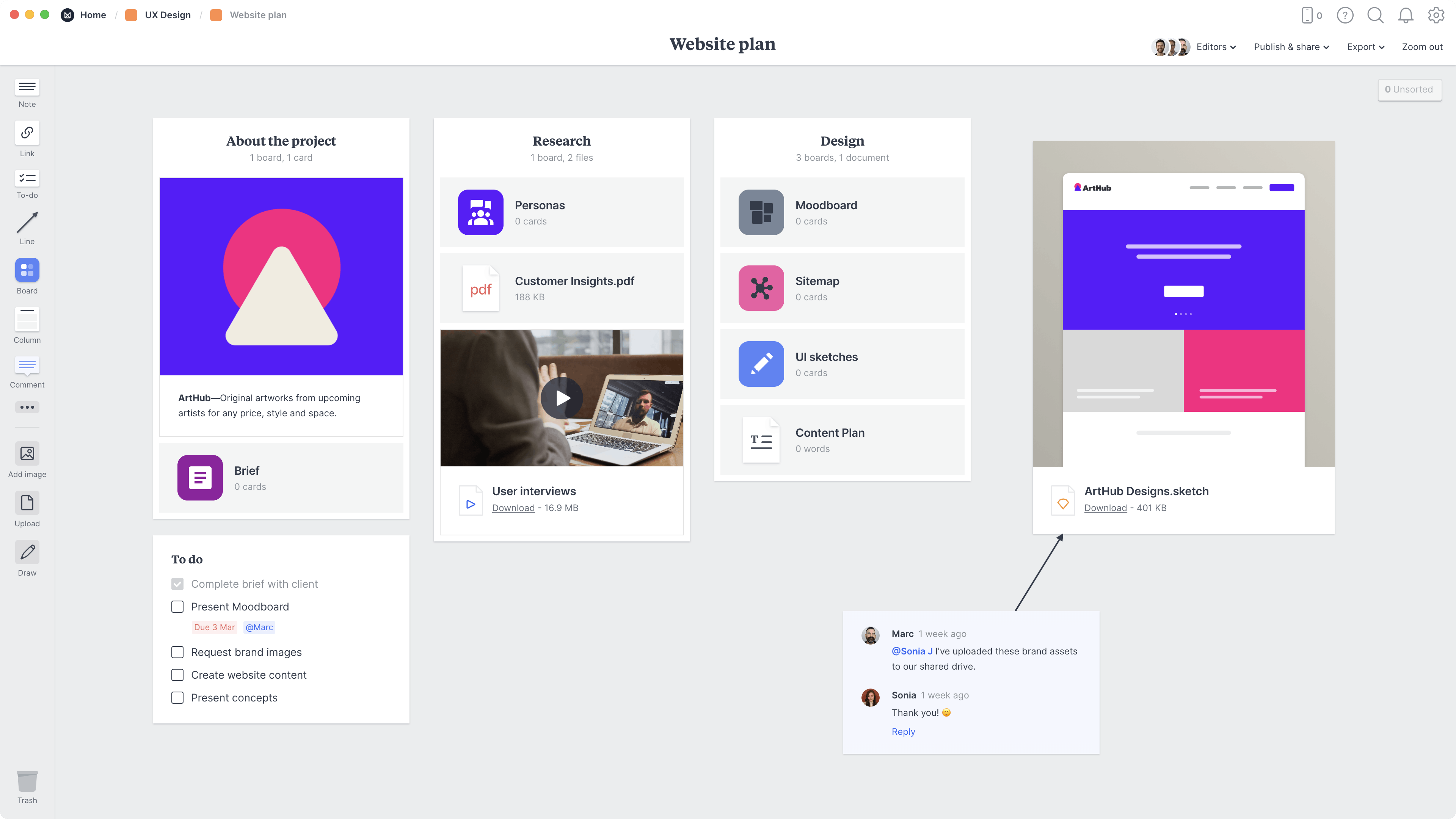
Collect inspiration for your website or app.
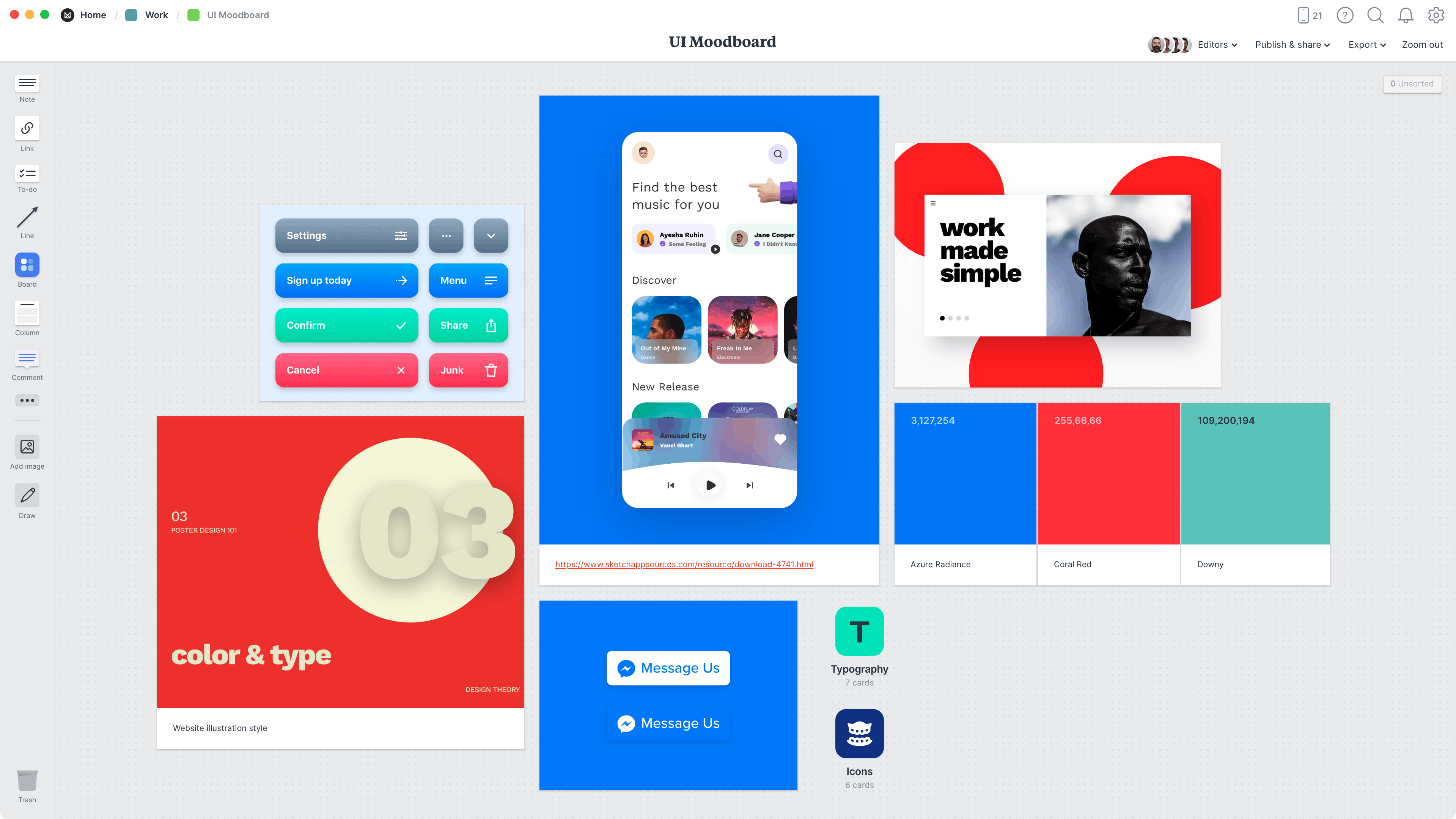
Set the project goals & deliverables.

Plan the perfect website structure.

Paint a picture of your ideal user.
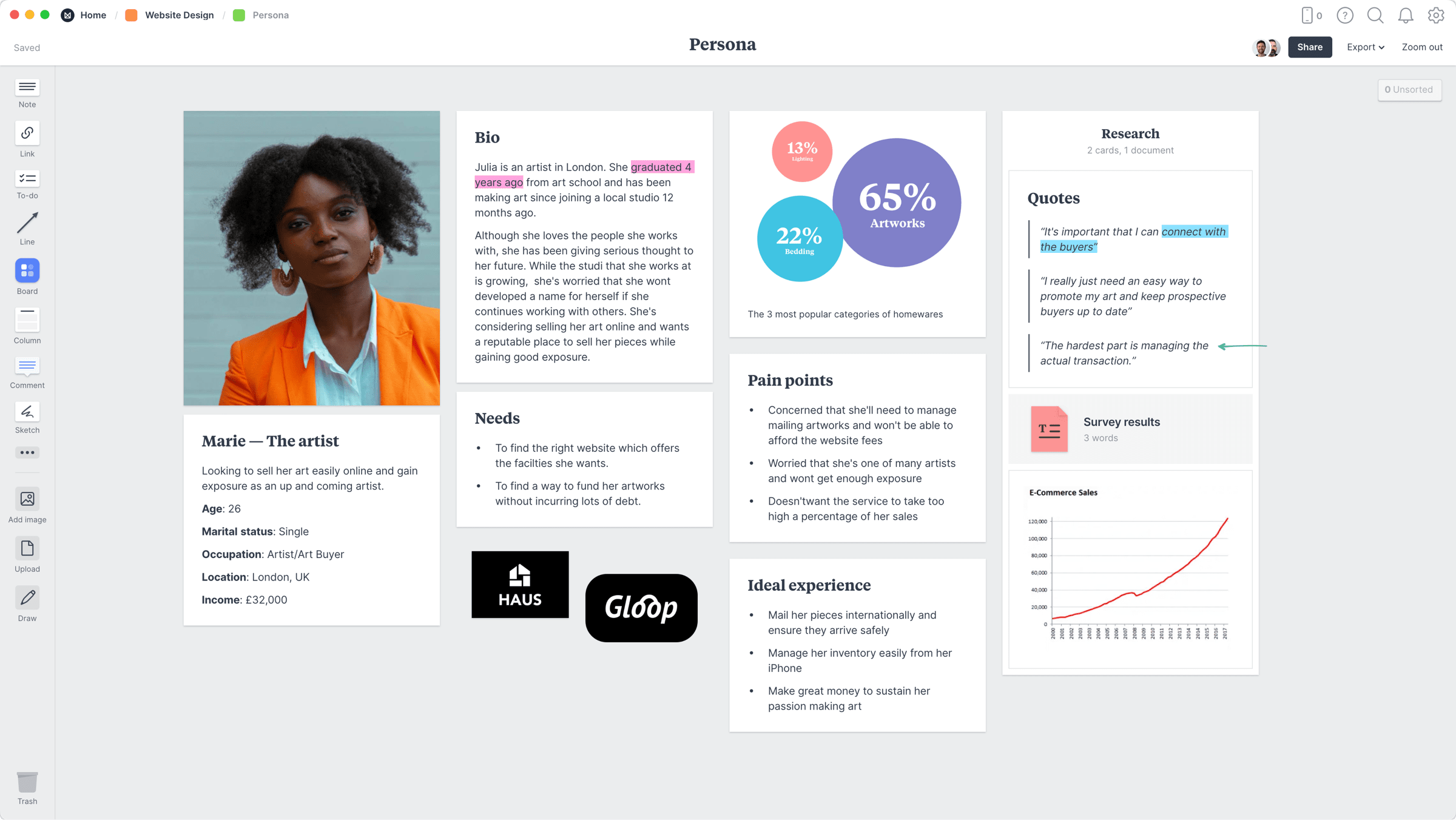
Creative professionals from these companies use Milanote
Start your brief.
Create a plan for your next UX research project.
Sign up for free with no time limit
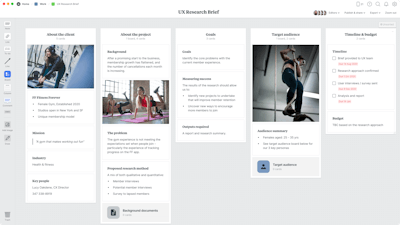
Milanote is where creative professionals organize their most important work.
Free with no time limit
Create your account
Free Research Brief Template
Fully editable with custom branding and pre-written services. Send and get read receipts.
Bonsai has helped create 1,023,928 documents and counting.

Table of contents

Do you have a freelance client who has given you a huge project? Are you currently in negotiation with one about a massive project? If you do, then it could be time to consider using a research brief template. The template offers consultants – and their clients – massive advantages. A freelance researcher needs as many tools as possible to deliver stunning work and results for the client.

The template offers you a myriad of benefits, as you will see below.
1. Improved communication with clients with your research brief template
Freelancers have to keep improving themselves. One way of doing that is by communicating better with their clients. A good consultant focuses on understanding the requirements of the project before commencing. The ability to understand is everything. Excellent communication with clients sets the pace for the rest of your relationship with the client. This important ingredient is necessary for setting the kind of foundation upon which success will emerge.
2. Obtaining crucial insights with your research brief template
The insights you obtain from the client about the project determines how much success you are likely to enjoy. The research brief template offers you all the insights you need moving forward. Without it, you would be unable to do anything meaningful. The most helpful insights tend to be the ones that are both relevant and actionable. The template offers clients an avenue through which to explain what they want in-depth.
3. Sustaining focus with your research brief template
At no time should the freelancer ever lose sight of the most important aspects of the project. The focus should remain on the most important components of the project. The research brief template plays a significant role in all this. It sets you on the road to victory. The template helps you to remain focused on building and sustaining healthy relationships with clients thus making it easier to accomplish all that you set out to do.
4. Defining problems and their solutions with your research brief sample
All freelancers are capable of defining and identifying the problems that their clients face. However, only the truly exceptional clients are capable of defining problems and identifying the appropriate solutions. More importantly, the template also offers consultant’s clients a chance to define and seek more clarification about the objectives . After all, each project has a few objectives. The solutions must meet or actualize the objectives in question.
5. The research brief example provides access to background information
Do you understand or approach the project based on the client’s perspective? If you don’t, it might be time to consider doing just that. Background information determines the direction the entire takes. Why is the client interested in proceeding with the project? What history do the clients have with the problems for which they need solutions? The research brief template provides answers to these questions via the background information.

6. Provide details regarding existing constraints in the research brief sample
A detailed understanding of everything the project is likely to encounter is crucial to its success. Without this information, you have little to no guarantee of success. Each project has its limitations that could be anything between budgetary or time-related constraints. It’s worth reminding freelancers that constraints are not necessarily bad or wrong. For this reason, constraints are worth embracing rather than hating.
A good brief contains constraints to help the freelancer to decide if the project is worth taking.
Lastly, the research brief template is a powerful tool for talking about methodologies and deliverables too. It clarifies strategies vis-à-vis research outputs. It talks about the schedule, costs, analysis and reporting, and everything else that is central to the success of the large project the consultant is about to embark upon. Essentially, you should never dive into a large project before going through and familiarizing yourself with all that the template says.

Free Performance Contract Template
Free Equipment Sales Agreement Template
Zoho Invoice Template
Wave Invoice Template
Free Product Sales Proposal Sample (PDF)
Free Data Entry Proposal Letter
Time tracking
Free Harvest Alternative
Free Creative Brief Template (Word)
Free Website Creative Brief
Free Website Brief Template
Free Video Brief Template
Free Strategy Brief
Title Block Template
Free UX Brief
Free Social Media Brief Template
Free Photography Brief Template
Free Project Brief Template
Free Product Brief Template
Research Brief Template

Download this Research Brief Template Design in Word, Google Docs, PDF Format. Easily Editable, Printable, Downloadable.
Don't waste time trying to create a research brief from scratch. Let Template.net's Research Brief Template do the heavy lifting for you. With this easy-to-use template, you can clearly outline your research objectives, methodology, and analysis in a fraction of the time. Stay organized and efficient with this indispensable tool.
Already a premium member? Sign in
- , Google Docs
You may also like

Surfer Academy Learn On-Page SEO with Michał Suski on August 22nd!
Hold that thought
Before you hit that X in the corner, remember that not using Surfer will add hours to your workflow, frown lines to your writers’ foreheads, and give an undeniable competitive edge to all those pages you’re trying to outrank!

The choice is yours, but the answer is clear.
Join 150k+ Agencies, Marketers, and SEOs.
Download SEO Content Brief Template For Blog Posts

Need your content to rank higher? An SEO content brief template can help. This guide shows you how to create effective briefs for better SEO results.
Key Takeaways
- An SEO content brief serves as a strategic guide for content creation, aligning with SEO goals and ensuring clarity for writers to produce high-quality content.
- Utilizing an SEO content brief template promotes team alignment, streamlines the writing process, and reduces production costs by clarifying expectations and minimizing revisions.
- Key elements of an effective SEO content brief include target audience insights, keywords, search intent understanding, and structured formatting to optimize content for SEO performance.
What Is an SEO Content Brief?
An SEO content brief is more than just a set of instructions; it’s a strategic document that guides the content creation process, ensuring alignment with your SEO efforts.
These briefs minimize misunderstandings and provide a clear structure for writers, which is crucial for producing high-quality, data-driven content.
Detailing the content’s purpose, target audience, and SEO-specific elements like keywords and competitive analysis streamlines production and improves outcomes.
They act as a blueprint, guiding writers to create content that aligns with goals and resonates with the audience.
Key components of an effective SEO content brief include the title, outlines, brand information, and sources. Understanding the target audience is paramount, enabling writers to craft seo focused content brief that is relevant and focused.
This structured approach aligns content with the overall strategy, contributing to successful marketing efforts.
Why Use an SEO Content Brief Template?
Using an SEO content brief template is like having a secret recipe for success. It aligns your entire team, ensuring everyone understands the article’s goals and maintains consistency across projects.
This cohesion is vital for a cohesive brand message and efficient content production.
SEO content briefs help writers meet deadlines by clarifying expectations, thus speeding up the draft submission process. Consolidating necessary information into a single document streamlines the writing process and enhances efficiency.
This structured approach not only improves the quality of articles but also reduces the costs associated with content production by minimizing revisions.
Detailed SEO content briefs boost the likelihood of receiving publish-ready articles, minimizing the need for multiple edits.
This efficiency translates to higher quality content that is more likely to rank well in search engines, making the investment in creating detailed content briefs worthwhile.
Essential Elements of an Effective SEO Content Brief
The backbone of a successful SEO content brief lies in its essential elements.
These elements include content goals, target audience, content type, and SEO-specific components like keywords. Clear instructions and detailed information for the writer are paramount.
Additionally, a comprehensive brief should encompass the target audience, resources, and desired call-to-action (CTA).
The more detailed the content brief, the smoother the content production process. This thoroughness ensures that every piece of content aligns with the content strategy and meets its intended goals.
Accurate audience insights, data for research, and context around a brand or product should also be included.
This holistic approach helps in creating high-quality content that resonates with the audience and fulfills the strategic objectives of the content marketing agency or content team.
Primary Keyword
The primary keyword serves as the cornerstone of your content, shaping its entire structure and focus. Conducting thorough keyword research helps identify topics that resonate with the target audience and ensures your content is built around terms with high search volume and relevancy, including the target keyword.
Incorporating the primary keyword into headlines, metadata, and subheadings is crucial for effective content targeting.
This integration not only guides the content structure but also enhances its visibility in search engines. Focusing on the primary keyword lays a strong foundation for content that ranks well and meets user expectations.
Secondary Keywords
Secondary keywords play a vital role in broadening the reach and improving the relevancy of your content.
Supporting the primary keyword helps capture additional traffic and address related search queries. This multi-faceted approach increases the chances of ranking for more keyword variations.
Incorporating secondary keywords enhances the overall SEO strategy by improving the content’s ability to rank for a wider range of terms.
This strategy not only boosts organic traffic but also ensures that the content is comprehensive and addresses various aspects of the topic.
Search Intent
Understanding search intent is a cornerstone of creating valuable SEO content. It ensures that your content aligns with user expectations and needs, significantly improving its chances of ranking well.
Tailoring content to match user intent involves identifying the type of content that users are searching for and ensuring it meets their needs.
Incorporating insights about the buyer’s journey stage into your SEO content helps craft targeted and effective calls-to-action.
Aligning the content type with audience expectations and competitive analysis enhances user satisfaction and improves SERP rankings.
Structuring Your SEO Content Brief
Structuring your SEO content brief is an art that involves creating a detailed and organized document. This structure helps writers understand the content requirements and ensures that search engines can easily index and rank the content.
A well-structured outline with headings and subheadings is essential.
On-page SEO elements like meta descriptions, headers, and keyword usage are crucial for optimizing the content.
Additionally, understanding the funnel stage helps select appropriate CTAs and links to guide readers closer to conversion.
Competitive guidance and a thorough understanding of the topics are vital for keeping readers engaged and aiding in SEO.
Including ‘People also ask’ questions in the content brief addresses user queries, enhancing content relevance and search rankings.
Page Title and Meta Description
The page title and meta description are critical on-page SEO elements that can significantly influence your content’s performance in search engines.
Incorporating the primary keyword into the page title and meta description is essential for on-page optimization. These elements should be crafted to capture attention and align with user search intent, ensuring that your content stands out in search results.
The meta description should provide a concise summary of the content, including the primary keyword, and should align with common keywords among ranking pages.
This not only helps search engines understand the content but also improves click-through rates by enticing users to visit your page.
The Technical Details section of an SEO content brief should include meta tags, descriptions, character count, keywords, and specific SEO directives to ensure all on-page SEO elements are covered.
Internal and External Links
Internal and external links are crucial components of a robust SEO strategy. Internal links help create content silos, drive relevancy, and improve rankings in search engine results.
When creating the content brief, it’s important to include URL and anchor text suggestions for internal links to guide writers in incorporating them naturally into the content.
External links, on the other hand, enhance the credibility of the content by referencing high-quality sources. Include URLs of relevant external sources and adhere to specific brand guidelines to improve content quality.
Tools like Outranking can assist in mapping the sitemap with keywords for relevant internal link suggestions, ensuring that both internal and external links are effectively utilized.
Content Length and Format
Determining the appropriate content length and format is essential for thorough topic coverage and meeting audience expectations.
The word count should be based on competitive analysis, ensuring your content is as detailed and informative as top-ranking competitors. Providing guidelines for word count in an SEO content brief helps ensure the topic is covered comprehensively.
Analyzing top-ranking competitors can also suggest suitable formats for your content.
Whether it’s blogs, landing pages, or whitepapers, indicating the ideal content format in the brief helps meet audience expectations and enhances the content’s effectiveness.
Detailed content offering unique insights can outrank high-performing competitor content.
Tools for Creating SEO Content Briefs
Several tools and automated analysis platforms can aid in the creation of effective SEO content briefs. Tools like Semrush and Outranking can automate brief creation, scaling content production and reducing team overload.
These tools gather semantic terms and provide formatting suggestions, enhancing the relevance and appearance of your content briefs.
Content Harmony’s workflow generates professionally-formatted content briefs based on live data, ensuring accuracy. Some content brief templates, like those from Brafton, include internal explanations to help writers understand the requirements.
The SERP Gap Analyzer assists in creating briefs by analyzing keyword opportunities and competitor content, providing a comprehensive overview of what’s needed to outrank competitors.
However, blindly trusting machine-generated content briefs can result in a lack of relevance to the specific article topic.
Combining automated tools with manual insights ensures that your briefs are both comprehensive and tailored to your specific needs.
Google Search Console
Google Search Console is a powerful tool for SEO content brief creation, especially for secondary keyword research. Analyzing the performance of keywords driving traffic to your site helps identify semantic search terms related to the primary keyword.
These insights help widen your potential to rank for more keywords beyond your primary terms, enhancing overall content visibility.
Incorporating these semantic search terms into your SEO content brief ensures comprehensive content aligned with user search behavior.
This approach not only improves your content’s relevance but also boosts its performance in search engine rankings, driving more organic traffic to your site.
Competitor Benchmarking Tools
Competitor benchmarking tools are invaluable for shaping your SEO content briefs by identifying gaps and opportunities. Measuring competitor content helps you understand why top-ranking articles perform well and allows you to create better content to outrank them.
Tools like Semrush and Ahrefs offer features like Content Gap analysis and keyword opportunity identification, which are essential for crafting superior content.
Moz Pro’s Rivalry metric ranks the top 25 SERP competitors based on shared keyword volume and authority, providing a detailed understanding of your competitive landscape.
The SEO Content Template tool from Semrush saves time by providing a list of the top 10 articles ranking for a topic, giving you a clear benchmark for your content creation efforts.
Manual Creation Techniques
While automated tools offer convenience, manually creating content briefs allows for more customization and depth. This method ensures that every aspect of the brief is tailored to the specific needs of the content and its goals.
Document the tools used and when they were utilized, and make the content briefs available in .doc file formats for easy access and editing.
Sharing the content brief link through task management systems or direct messages ensures that all team members have access to the necessary information. While automated tools can assist in gathering data, relying solely on them may result in missing critical in-depth elements necessary for effective briefs.
A balanced approach that combines manual insights with automated data is ideal for creating comprehensive and customized content briefs.
Common Mistakes to Avoid in SEO Content Briefs
Creating an effective SEO content brief involves avoiding several common pitfalls. Overemphasizing keywords can lead to keyword stuffing, which compromises content quality and readability.
It’s crucial to provide a manageable list of keywords and clear instructions on their integration to maintain a natural flow.
Ignoring search intent can negatively affect content performance and user satisfaction. Ensuring that your content aligns with what users are searching for enhances relevancy and boosts engagement.
Finally, a lack of clear instructions in content briefs can cause confusion and prevent content from meeting its objectives.
A comprehensive brief enhances collaboration among team members, reducing the number of revisions needed.
Overemphasis on Keywords
Providing a long list of target keywords can overwhelm content creators and lead to over-optimization, resulting in unnatural-sounding text. It’s essential to avoid keyword stuffing and excessive focus on keyword density.
Instead, include SEO recommendations in the content brief to ensure that content quality is not compromised by excessive keyword usage.
Clear instructions on how keywords should be integrated into the content help maintain a balance between optimization and readability. This approach ensures that the content remains engaging and relevant while still meeting SEO requirements.
Ignoring Search Intent
Understanding search intent is crucial for creating content that meets audience expectations. When content aligns with search intent, it enhances relevancy and boosts user satisfaction.
Tools like SparkToro and BuzzSumo can provide valuable audience insights and engagement metrics, helping you tailor your content to match user needs.
Neglecting search intent can lead to misaligned content, reducing visibility and engagement. Ensuring that your content addresses user queries and matches their search intent improves its chances of ranking well and driving organic traffic.
Lack of Clear Instructions
Effective SEO content briefs eliminate guesswork by providing crucial data-driven insights on audience behavior and needs.
Comprehensive audience insights can greatly enhance the effectiveness of content briefs, ensuring that the content meets its objectives.
Implementing feedback mechanisms allows continuous improvement of content quality and alignment with goals.
Providing clear and detailed instructions helps avoid confusion and ensures that the content creation process runs smoothly, reducing the need for multiple rounds of revisions.
Customizing Your SEO Content Brief Template
Customizing your SEO content brief template enhances clarity on editorial intent and contextual information. Tailoring the brief to the specific needs of the content ensures that all relevant details are included, making the brief more effective.
Clear communication about the buyer’s journey stage allows the content to be tailored for the specific type of prospect.
Adapting for Different Content Types
Adapting content brief templates for various content formats ensures clarity and relevance in the final output. Different content types, such as blogs, landing pages, and whitepapers, require specific considerations regarding content length and format.
Customizing the content brief template involves tailoring sections to align with the specific goals and characteristics of the content type.
Incorporating brand voice ensures consistency across content formats, while feedback loops help refine the content based on audience response.
This approach ensures that each piece of content meets the desired objectives and maintains a cohesive brand message.
Incorporating Brand Voice
A clear description of brand voice in the content brief helps writers convey the right message and maintain brand identity. This consistency is crucial for building a strong brand presence and ensuring that all content aligns with the overall brand strategy.
Integrating Feedback Loops
Feedback loops allow for ongoing evaluation of content quality, ensuring that it meets ever-evolving SEO standards.
Establishing clear channels for feedback helps identify areas of improvement early in the content creation process, making it easier to implement changes.
Regularly revisiting and revising SEO strategies based on ongoing feedback ensures that content quality remains relevant and effective over time.
This continuous improvement cycle reinforces a culture of learning and adaptation within content creation teams, ultimately leading to better content and improved SEO performance.
In summary, an effective SEO content brief is a powerful tool that guides the content creation process, ensuring alignment with SEO goals and improving the quality of the final output.
Key elements such as primary and secondary keywords, search intent, and clear instructions are crucial for crafting content that resonates with the target audience and ranks well in search engines.
Using SEO content brief templates enhances consistency, efficiency, and quality across content projects.
Customizing these templates to suit different content types and incorporating brand voice ensures that all content aligns with the overall strategy and maintains a cohesive brand message.
By avoiding common mistakes and integrating feedback loops, you can continuously improve your content briefs and overall SEO strategy. Implementing these practices will help you produce high-quality content that meets user expectations and achieves top-ranking results.
Frequently Asked Questions
What is an seo content brief.
An SEO content brief is a strategic document that outlines content requirements and SEO objectives, helping writers produce aligned and optimized material. By utilizing a well-structured brief, you can enhance your content's effectiveness in achieving search engine visibility.
Why should I use an SEO content brief template?
An SEO content brief template ensures consistency, aligns your team, and streamlines the content creation process, ultimately enhancing the quality and efficiency of your projects. Adopting this approach can lead to more effective and focused content.
What are the key elements of an effective SEO content brief?
An effective SEO content brief should include primary and secondary keywords, search intent, content goals, target audience, and clear instructions for the writer. These elements ensure that the content is well-targeted and optimized for search engines.
How can I customize an SEO content brief template?
You can customize your SEO content brief template by aligning sections to specific content types, incorporating your brand's unique voice, and including feedback loops for ongoing enhancement. This approach ensures that the brief remains relevant and effective for your needs.
What tools can I use to create SEO content briefs?
To create effective SEO content briefs, utilize tools such as Semrush, Outranking, Google Search Console, and competitor benchmarking tools. These resources will help you develop comprehensive briefs that enhance your content's SEO performance.
https://surferseo.com/blog/seo-content-brief-template/
7-day Money-Back Guarantee
Choose a plan that fits your needs and try Surfer out for yourself. If you won’t be satisfied, we’ll give you a refund (yes, that’s how sure we are you’ll love it)!


IMAGES
COMMENTS
Crafted for simplicity and effectiveness, our research project brief template is the key to successful research management. It's perfect for researchers, academic institutions, and businesses aiming to conduct research with precision and ease. This template is a clear guide, aligning every project detail for smooth progress.
The quality of your research brief will hugely impact your results. Here's our 'how to' guide on writing an effective research brief.
Creating a brief is one of the most important initiating steps for market research, as it provides the necessary information that researchers need to understand your needs as much as you do yourself. Find out how to write the perfect brief (and download our free template) here.
Crafting a research brief that yields results is crucial. Explore the seven essential steps to write an effective research brief, ensuring success in your projects. Learn from experts and avoid common pitfalls.
A project brief an important document when managing your project. Learn how it commuincates to stakeholders and guides your team.
Learn what a project brief is and how it's used in project management. Plus, download a free template and example to create a simple brief for your project.
A good market research brief helps agencies lead successful projects. Learn what to include and how to write a detailed brief with our template guide.
Write a research briefing This guide will help you to structure a research briefing. It provides a set of questions and prompts to consider before you start writing, a suggested structure and practical tips.
Research brief format are invaluable tools for distilling complex research findings into an easily digestible format for busy stakeholders. A well-structured research brief gets the most important information in front of decision-makers, policymakers, and other non-technical audiences. This guide breaks down the essential elements that make a research brief impactful and easy to understand.
Market Research Brief Template Market research plays a crucial role in the success of any business. By providing valuable insights into customers, competitors, and market trends, it helps companies make informed decisions and develop effective strategies. A well-designed market research brief is the foundation of any successful research project. It helps define the objectives, scope, and ...
A typical brief should include background information, objectives of the research, details on the product/service being studied, who the target market is, key dates, budget information, and access to any past research. Read our guide on writing inspiring creative briefs to learn more. This template is part of the Marketers collection.
A research proposal aims to show why your project is worthwhile. It should explain the context, objectives, and methods of your research.
Introduction (about 50 to 100 words) Write a one-paragraph introduction (50 to 100 words) summarizing the policy problem, the research question, and the key findings. Use the introduction and conclusion to the discussion paper as sources for the introduction (and conclusion) of the brief. This is your homework!
A project brief is a concise, high-level summary of your project plan that teams share with stakeholders. A brief only includes essential project information. A project plan, however, includes detailed information about all project elements. A project plan is a multipage document that outlines and defines a project in its entirety.
Save time, keep teams aligned, and provide a standardized structure for managing design projects with these 10 free project brief templates.
A project brief is your team's central source of truth for key project information. Learn how a project brief can help you manage a successful project.
Download our project brief template to create a succinct summary of your project for your team and stakeholders.
A step-by-step guide for success Writing a research brief that is effective and yields results isn't always easy. But time invested Writing upfront a will research pay dividends brief that for is the effective life of your and yields project, results and ultimately, isn't always might easy. be But the time difference invested upfront between will reaching pay dividends your objectives for ...
12 Free Project Brief Templates & Examples (Word | PDF) At some point, you might wonder why a given project doesn't turn out the way you expected it to be. Usually, this is a common problem experienced by inexperienced marketers and designers. Well, if you have experienced such, it's probably because you didn't define the project objectives, expectations, and deliverables earlier on ...
Find out what a research proposal is and when you should write it. This article also has expert tips and advice on how to write one, along with research proposal examples.
The perfect start to a UX research project. The best products and services are built with an intimate insight into its customers. To achieve this level of insight requires user research, and great user research starts with a clear brief.
A project brief is a clear summary of what will happen in a project and how you'll be doing it. This editable, pro-designed brief template gets you started.
2. Obtaining crucial insights with your research brief template The insights you obtain from the client about the project determines how much success you are likely to enjoy. The research brief template offers you all the insights you need moving forward. Without it, you would be unable to do anything meaningful.
Instantly Download Research Brief Template, Sample & Example in Microsoft Word (DOC), Google Docs, Format. Available in A4 & US Letter Sizes. Quickly Customize. Easily Editable & Printable.
Why Use an SEO Content Brief Template? Using an SEO content brief template is like having a secret recipe for success. It aligns your entire team, ensuring everyone understands the article's goals and maintains consistency across projects. This cohesion is vital for a cohesive brand message and efficient content production.